8
Dr. Renee M. Gondek; Dr. Jeffrey Becker; Dr. Steven Zucker; Dr. Beth Harris; and Lumen Learning
In this chapter
Introduction: The Ancient Greeks & Their Gods
Geometric & Orientalizing
Archaic
- Attic Black-Figure Amphora with Ajax and Achilles Playing a Game
- Sculpture in the Archaic period
- Lady of Auxerre
Early Classical
High Classical
Late Classical
Hellenistic
Introduction to ancient Greek art
A shared language, religion, and culture
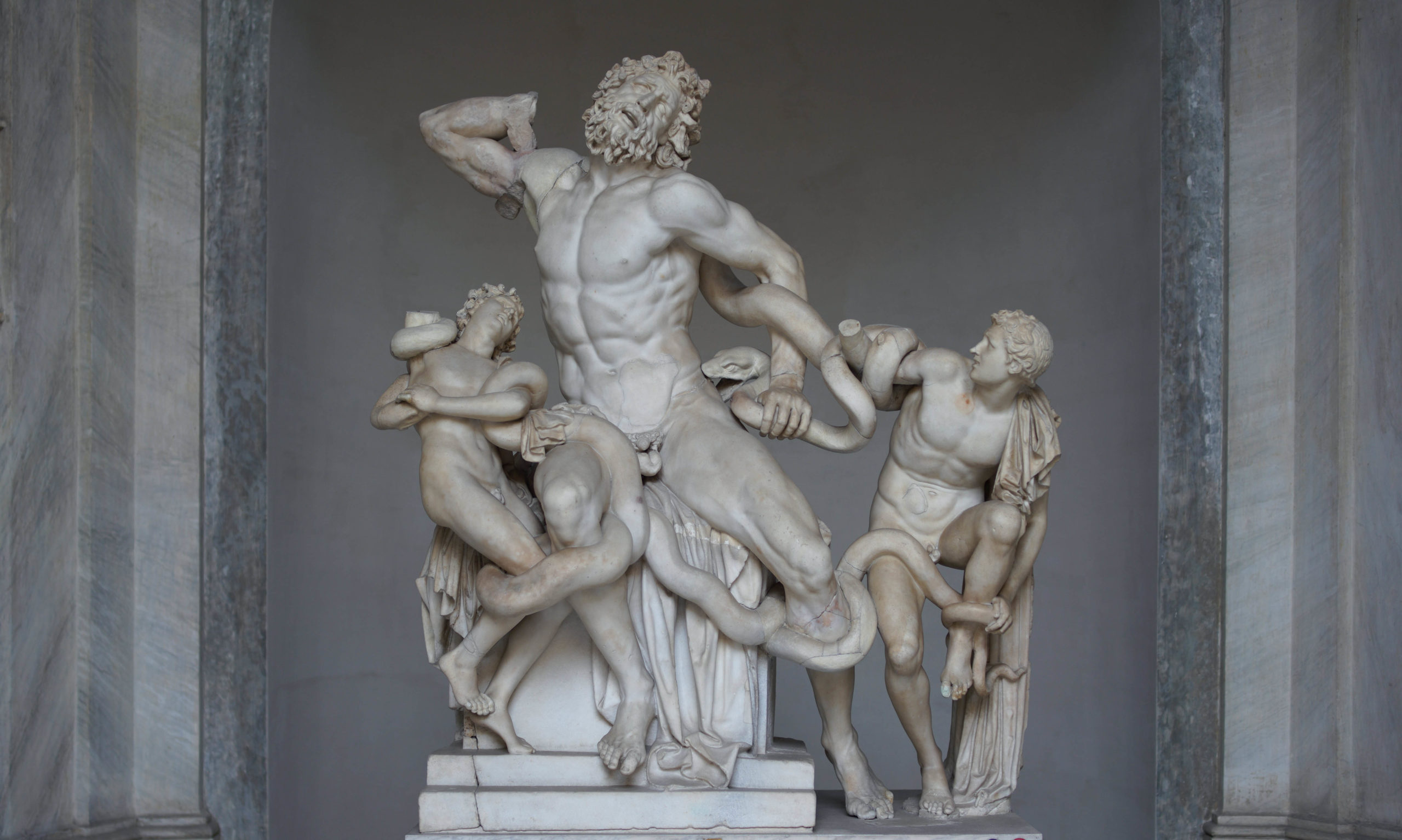
Ancient Greece can feel strangely familiar. From the exploits of Achilles and Odysseus, to the treatises of Aristotle, from the exacting measurements of the Parthenon (image above) to the rhythmic chaos of the Laocoön (image below), ancient Greek culture has shaped our world. Thanks largely to notable archaeological sites, well-known literary sources, and the impact of Hollywood (Clash of the Titans, for example), this civilization is embedded in our collective consciousness—prompting visions of epic battles, erudite philosophers, gleaming white temples, and limbless nudes (we now know the sculptures—even the ones that decorated temples like the Parthenon—were brightly painted, and, of course, the fact that the figures are often missing limbs is the result of the ravages of time).
Dispersed around the Mediterranean and divided into self-governing units called poleis or city-states, the ancient Greeks were united by a shared language, religion, and culture. Strengthening these bonds further were the so-called “Panhellenic” sanctuaries and festivals that embraced “all Greeks” and encouraged interaction, competition, and exchange (for example the Olympics, which were held at the Panhellenic sanctuary at Olympia). Although popular modern understanding of the ancient Greek world is based on the classical art of fifth century B.C.E. Athens, it is important to recognize that Greek civilization was vast and did not develop overnight.

The Dark Ages (c. 1100–c. 800 BCE) to the Orientalizing Period (c. 700–600 BCE)
Following the collapse of the Mycenaean citadels of the late Bronze Age, the Greek mainland was traditionally thought to enter a “Dark Age” that lasted from c. 1100 until c. 800 B.C.E. Not only did the complex socio-cultural system of the Mycenaeans disappear, but also its numerous achievements (i.e., metalworking, large-scale construction, writing). The discovery and continuous excavation of a site known as Lefkandi, however, drastically alters this impression. Located just north of Athens, Lefkandi has yielded an immense apsidal structure (almost fifty meters long), a massive network of graves, and two heroic burials replete with gold objects and valuable horse sacrifices. One of the most interesting artifacts, ritually buried in two separate graves, is a centaur figurine (see photos below). At fourteen inches high, the terracotta creature is composed of a equine (horse) torso made on a potter’s wheel and hand-formed human limbs and features. Alluding to mythology and perhaps a particular story, this centaur embodies the cultural richness of this period.

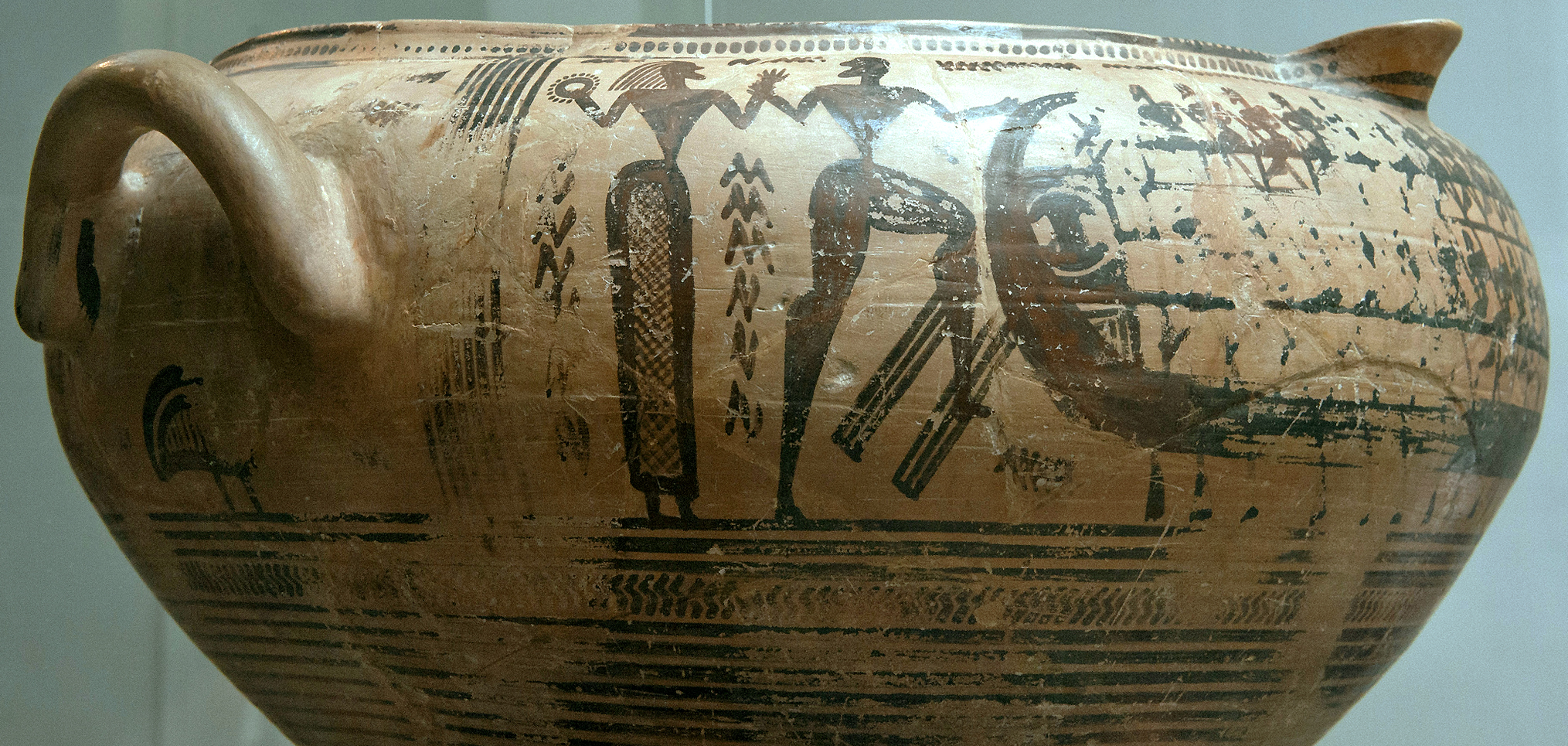
Similar in its adoption of narrative elements is a vase-painting likely from Thebes dating to c. 730 B.C.E. (see image below). Fully ensconced in the Geometric Period (c. 800-700 B.C.E.), the imagery on the vase reflects other eighth-century artifacts, such as the Dipylon Amphora, with its geometric patterning and silhouetted human forms. Though simplistic, the overall scene on this vase seems to record a story. A man and woman stand beside a ship outfitted with tiers of rowers. Grasping at the stern and lifting one leg into the hull, the man turns back towards the female and takes her by the wrist. Is the couple Theseus and Ariadne? Is this an abduction? Perhaps Paris and Helen? Or, is the man bidding farewell to the woman and embarking on a journey as had Odysseus and Penelope? The answer is unattainable.
In the Orientalizing Period (700-600 B.C.E.), alongside Near Eastern motifs and animal processions, craftsmen produced more nuanced figural forms and intelligible illustrations. For example, terracotta painted plaques from the Temple of Apollo at Thermon (c. 625 B.C.E.) are some of the earliest evidence for architectural decoration in Iron Age Greece. Once ornamenting the surface of this Doric temple (most likely as metopes), the extant panels have preserved various imagery. On one plaque (see image below), a male youth strides towards the right and carries a significant attribute under his right arm—the severed head of the Gorgon Medusa (her face is visible between the right hand and right hip of the striding figure). Not only is the painter successful here in relaying a particular story, but also the figure of Perseus shows great advancement from the previous century. The limbs are fleshy, the facial features are recognizable, and the hat and winged boots appropriately equip the hero for fast travel.
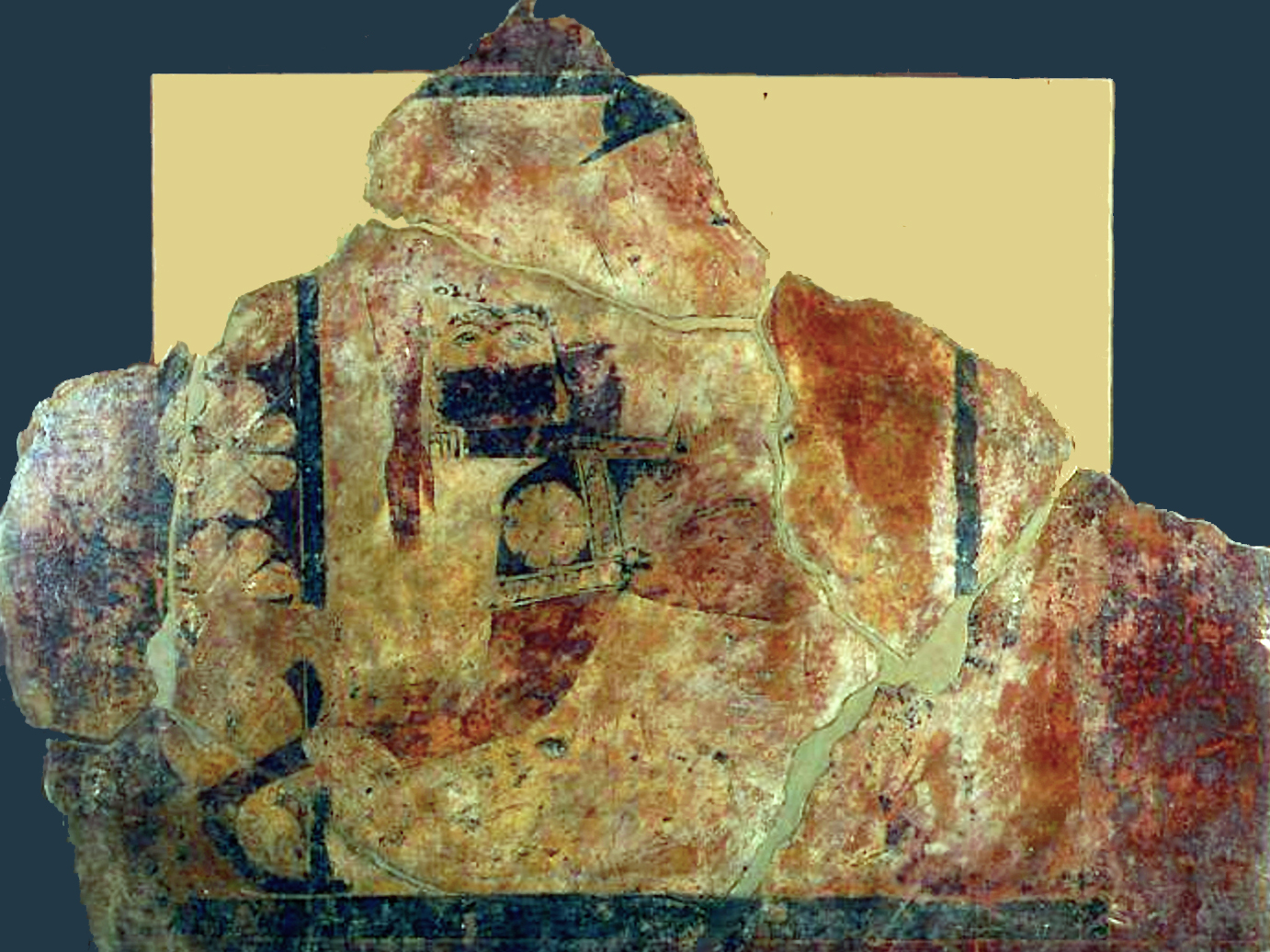
The Archaic Period (c. 600-480/479 B.C.E.)
While Greek artisans continued to develop their individual crafts, storytelling ability, and more realistic portrayals of human figures throughout the Archaic Period, the city of Athens witnessed the rise and fall of tyrants and the introduction of democracy by the statesman Kleisthenes in the years 508 and 507 B.C.E.

Visually, the period is known for large-scale marble kouros (male youth) and kore (female youth) sculptures (see below). Showing the influence of ancient Egyptian sculpture (compare Menkaure and Queen from Ancient Egypt), the kouros stands rigidly with both arms extended at the side and one leg advanced. Frequently employed as grave markers, these sculptural types displayed unabashed nudity, highlighting their complicated hairstyles and abstracted musculature (below left). The kore, on the other hand, was never nude. Not only was her form draped in layers of fabric, but she was also ornamented with jewelry and adorned with a crown. Though some have been discovered in funerary contexts, like Phrasiklea (below right), a vast majority were found on the Acropolis in Athens. Ritualistically buried following desecration of this sanctuary by the Persians in 480 and 479 B.C.E., dozens of korai were unearthed alongside other dedicatory artifacts. While the identities of these figures have been hotly debated in recent times, most agree that they were originally intended as votive offerings to the goddess Athena.
The Classical Period (480/479-323 B.C.E.)
Though experimentation in realistic movement began before the end of the Archaic Period, it was not until the Classical Period that two- and three-dimensional forms achieved proportions and postures that were naturalistic. The “Early Classical Period” (480/479 – 450 B.C.E., also known as the “Severe Style”) was a period of transition when some sculptural work displayed archaizing holdovers. As can be seen in the Kritios Boy, c. 480 B.C.E., the “Severe Style” features realistic anatomy, serious expressions, pouty lips, and thick eyelids. For painters, the development of perspective and multiple ground lines enriched compositions, as can be seen on the Niobid Painter’s vase in the Louvre (below).

During the “High Classical Period” (450-400 B.C.E.), there was great artistic success: from the innovative structures on the Acropolis to Polykleitos’ visual and cerebral manifestation of idealization in his sculpture of a young man holding a spear, the Doryphoros or “Canon” (image below). Concurrently, however, Athens, Sparta, and their mutual allies were embroiled in the Peloponnesian War, a bitter conflict that lasted for several decades and ended in 404 B.C.E. Despite continued military activity throughout the “Late Classical Period” (400-323 B.C.E.), artistic production and development continued apace. In addition to a new figural aesthetic in the fourth century known for its longer torsos and limbs, and smaller heads (for example, the Apoxyomenos), the first female nude was produced. Known as the Aphrodite of Knidos, c. 350 B.C.E., the sculpture pivots at the shoulders and hips into an S-Curve and stands with her right hand over her genitals in a pudica (or modest Venus) pose. Exhibited in a circular temple and visible from all sides, the Aphrodite of Knidos became one of the most celebrated sculptures in all of antiquity.

The Hellenistic Period and Beyond (323 B.C.E. – 31 B.C.E.)
- Following the death of Alexander the Great in 323 B.C.E., the Greeks and their influence stretched as far east as modern India. While some pieces intentionally mimicked the Classical style of the previous period such as Eutychides’ Tyche of Antioche (Louvre), other artists were more interested in capturing motion and emotion. For example, on the Great Altar of Zeus from Pergamon (below) expressions of agony and a confused mass of limbs convey a newfound interest in drama.
-

Athena defeats Alkyoneus (detail), The Pergamon Altar, c. 200-150 B.C.E. (Hellenistic Period), 35.64 x 33.4 meters, marble (Pergamon Museum, Berlin)
Architecturally, the scale of structures vastly increased, as can be seen with the Temple of Apollo at Didyma, and some complexes even terraced their surrounding landscape in order to create spectacular vistas as can be seem at the Sanctuary of Asklepios on Kos. Upon the defeat of Cleopatra at the Battle of Actium in 31 B.C.E., the Ptolemaic dynasty that ruled Egypt and, simultaneously, the Hellenistic Period came to a close. With the Roman admiration of and predilection for Greek art and culture, however, Classical aesthetics and teachings continued to endure from antiquity to the modern era.
Greek architectural orders
An architectural order describes a style of building. In classical architecture each order is readily identifiable by means of its proportions and profiles, as well as by various aesthetic details. The style of column employed serves as a useful index of the style itself, so identifying the order of the column will then, in turn, situate the order employed in the structure as a whole. The classical orders—described by the labels Doric, Ionic, and Corinthian—do not merely serve as descriptors for the remains of ancient buildings, but as an index to the architectural and aesthetic development of Greek architecture itself.
The Doric order
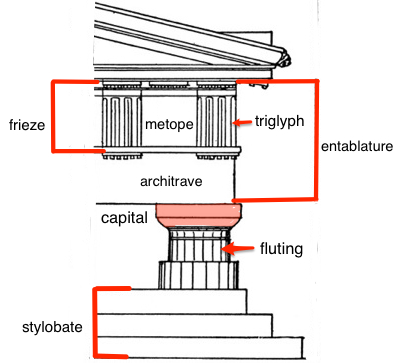
The Doric order is the earliest of the three Classical orders of architecture and represents an important moment in Mediterranean architecture when monumental construction made the transition from impermanent materials (i.e. wood) to permanent materials, namely stone. The Doric order is characterized by a plain, unadorned column capital and a column that rests directly on the stylobate of the temple without a base. The Doric entablature includes a frieze composed of trigylphs (vertical plaques with three divisions) and metopes (square spaces for either painted or sculpted decoration). The columns are fluted and are of sturdy, if not stocky, proportions.
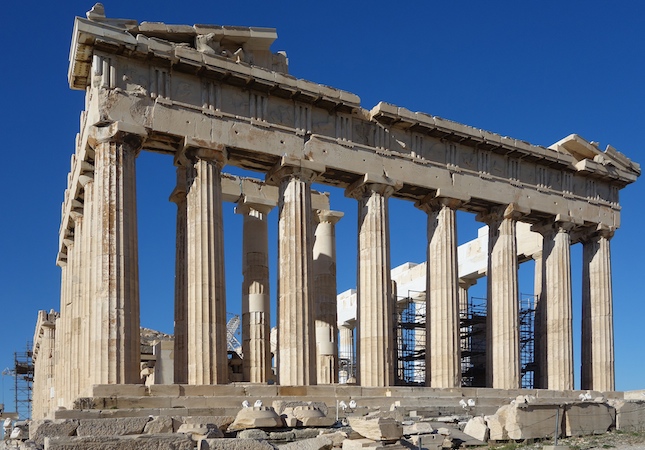
The Doric order emerged on the Greek mainland during the course of the late seventh century B.C.E. and remained the predominant order for Greek temple construction through the early fifth century B.C.E., although notable buildings of the Classical period—especially the canonical Parthenon in Athens—still employ it. By 575 B.C.E the order may be properly identified, with some of the earliest surviving elements being the metope plaques from the Temple of Apollo at Thermon. Other early, but fragmentary, examples include the sanctuary of Hera at Argos, votive capitals from the island of Aegina, as well as early Doric capitals that were a part of the Temple of Athena Pronaia at Delphi in central Greece. The Doric order finds perhaps its fullest expression in the Parthenon (c. 447-432 B.C.E.) at Athens designed by Iktinos and Kallikrates.
The Ionic order
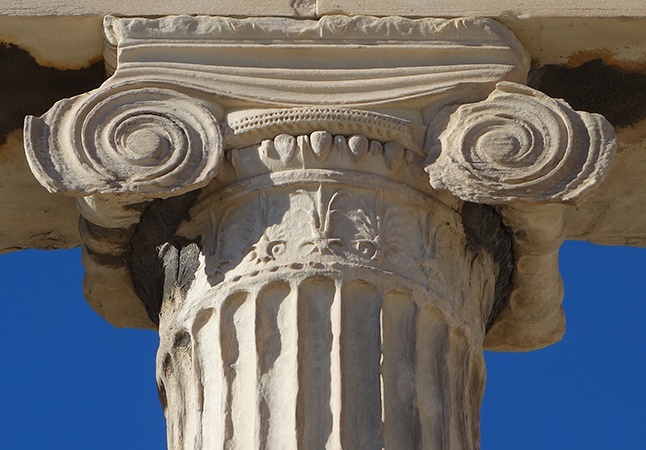

As its names suggests, the Ionic Order originated in Ionia, a coastal region of central Anatolia (today Turkey) where a number of ancient Greek settlements were located. Volutes (scroll-like ornaments) characterize the Ionic capital and a base supports the column, unlike the Doric order. The Ionic order developed in Ionia during the mid-sixth century B.C.E. and had been transmitted to mainland Greece by the fifth century B.C.E. Among the earliest examples of the Ionic capital is the inscribed votive column from Naxos, dating to the end of the seventh century B.C.E.
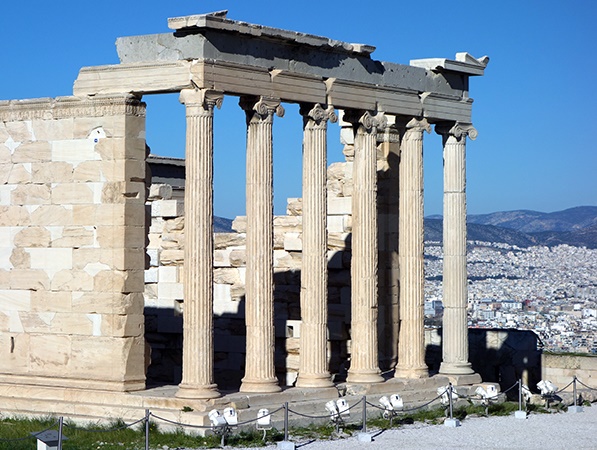
The monumental temple dedicated to Hera on the island of Samos, built by the architect Rhoikos, c. 570-560 B.C.E., was the first of the great Ionic buildings, although it was destroyed by earthquake in short order. The sixth century B.C.E. Temple of Artemis at Ephesus, a wonder of the ancient world, was also an Ionic design. In Athens the Ionic order influences some elements of the Parthenon (447-432 B.C.E.), notably the Ionic frieze that encircles the cella of the temple. Ionic columns are also employed in the interior of the monumental gateway to the Acropolis known as the Propylaia (c. 437-432 B.C.E.). The Ionic was promoted to an exterior order in the construction of the Erechtheion (c. 421-405 B.C.E.) on the Athenian Acropolis.The Ionic order is notable for its graceful proportions, giving a more slender and elegant profile than the Doric order. The ancient Roman architect Vitruvius compared the Doric module to a sturdy, male body, while the Ionic was possessed of more graceful, feminine proportions. The Ionic order incorporates a running frieze of continuous sculptural relief, as opposed to the Doric frieze composed of triglyphs and metopes.
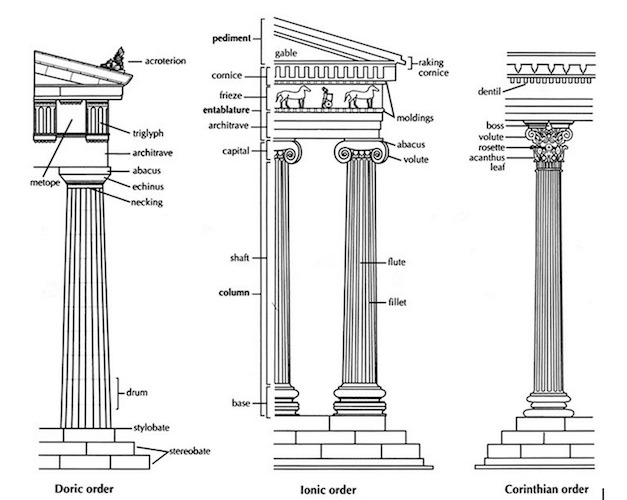
The Corinthian order
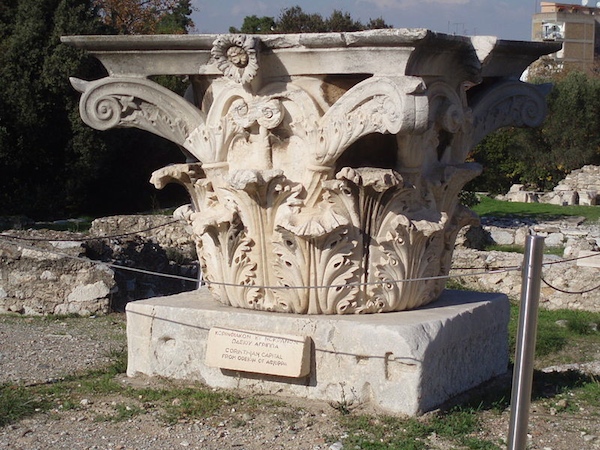
The Corinthian order is both the latest and the most elaborate of the Classical orders of architecture. The order was employed in both Greek and Roman architecture, with minor variations, and gave rise, in turn, to the Composite order. As the name suggests, the origins of the order were connected in antiquity with the Greek city-state of Corinth where, according to the architectural writer Vitruvius, the sculptor Callimachus drew a set of acanthus leaves surrounding a votive basket (Vitr. 4.1.9-10). In archaeological terms the earliest known Corinthian
capital comes from the Temple of Apollo Epicurius at Bassae and dates to c. 427 B.C.E.

The defining element of the Corinthian order is its elaborate, carved capital, which incorporates even more vegetal elements than the Ionic order does. The stylized, carved leaves of an acanthus plant grow around the capital, generally terminating just below the abacus. The Romans favored the Corinthian order, perhaps due to its slender properties. The order is employed in numerous notable Roman architectural monuments, including the Temple of Mars Ultor and the Pantheon in Rome, and the Maison Carrée in Nîmes.
Legacy of the Greek architectural canon
The canonical Greek architectural orders have exerted influence on architects and their imaginations for thousands of years. While Greek architecture played a key role in inspiring the Romans, its legacy also stretches far beyond antiquity. When James “Athenian” Stuart and Nicholas Revett visited Greece during the period from 1748 to 1755 and subsequently published The Antiquities of Athens and Other Monuments of Greece (1762) in London, the Neoclassical revolution was underway. Captivated by Stuart and Revett’s measured drawings and engravings, Europe suddenly demanded Greek forms. Architects the likes of Robert Adam drove the Neoclassical movement, creating buildings like Kedleston Hall, an English country house in Kedleston, Derbyshire. Neoclassicism even jumped the Atlantic Ocean to North America, spreading the rich heritage of Classical architecture even further—and making the Greek architectural orders not only extremely influential, but eternal.
Dipylon Amphora: A Conversation
by Dr. Steven Zucker and Dr. Beth Harris

As tall as a person, this pot is covered with geometric patterns and early figural representations. This is the transcript of a conversation conducted at the National Archaeological Museum in Athens. To watch the video: youtube.com/watch?v=Uwpdiq9mYME.
Steven: We’re in the National Archeological Museum in Athens looking at the Dipylon Vase.
Beth: The so-called Dipylon Vase because it was found near what would later become the Dipylon Gate in Athens and a cemetery right near there.
Steven: So this is a gigantic, ceramic pot. It’s an anaphora. But it would have been used as a grave marker in antiquity and it’s big. It’s five feet one inch tall.
Beth: Yeah, it’s almost as tall as I am. It’s unusual in that we see figures. We see a narrative scene and this is something that we see emerging more and more in the late geometric period. And geometric is such an obvious name for the style of this vase.
Steven: Well look at the vase, it’s covered from its foot all the way to the lip of its mouth with sharp-edged geometric patterns. I see meanders, I see diamonds, I see triangles. This is a pot coming out of that ancient tradition which really avoided empty space.
Beth: We do see black bands around the base where the neck meets the body and at the very lip of the vase. So we do have some black bands designating the separate parts of the vase.
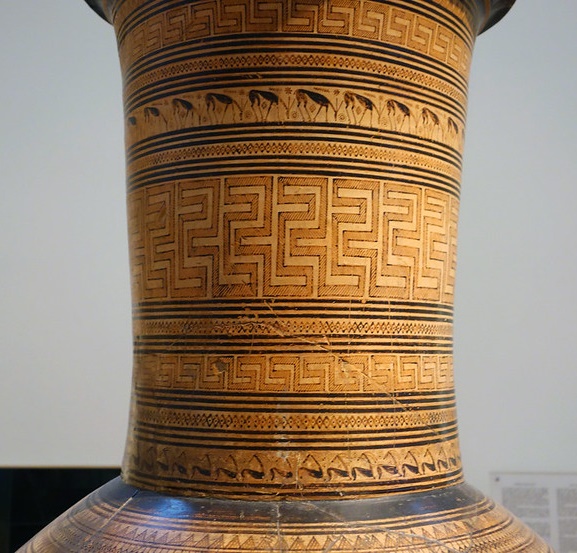
Steven: But the most interesting part is the fact that we have emerging here representations of animals and even of people. As you said we only see that at the end of the geometric period.
Beth: On the neck of the vase we see deer grazing.
Steven: Below that we see what are either goats or gazelles perhaps or some people have said deer as well.
Beth: Lying down or seated.
Steven: But notice in both cases with the deer and with the goats, it’s really a repeated motif so that it is a continuation of that pattern that is so much a part even of the non-figurative areas of the pot.
Beth: It’s true in the bodies of the animals are reduced to geometric shapes, each one is exactly identical to the one before and the one after and they’re almost easy to miss as animal figures.
Steven: Because they are so much a part of the pattern of the pot.
Beth: Exactly.
Steven: But in the main phrase at the shoulder of the pot, almost at its widest point.
Beth: Right where the handles meet the body.
Steven: We see a number of mourning figures on either side of the body of a dead woman.
Beth: Now we know it’s a woman because she is wearing a skirt and different genders were identified in that way and she’s lying on a funeral bier with a shroud held above her.
Steven: You see figures pulling at their hair, this is a symbol of mourning. Some people have even interpreted the little M-shaped patterns falling between the figures as tears.
Beth: Look at how the artist has avoided leaving any space blank. Even between those M-shapes, he’s painted little star shapes to fill in the blank spaces.
Steven: Below the dead woman we can see perhaps the family. We see larger figures on their knees and then we see smaller figures, perhaps the children.
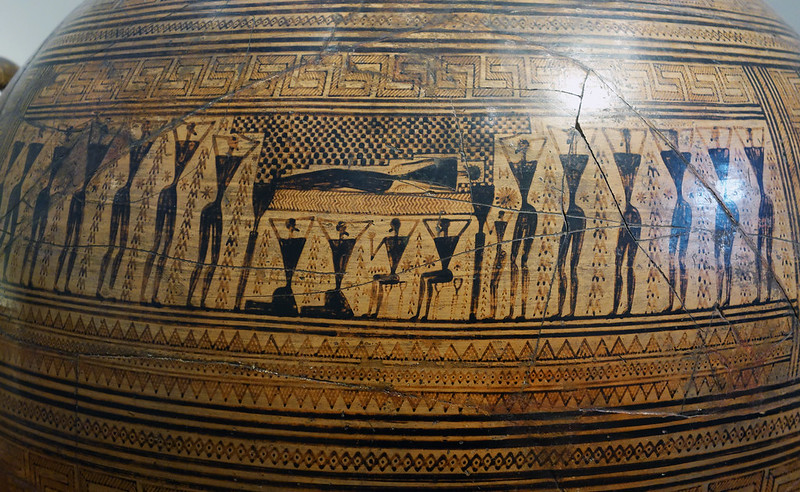
Beth: The bodies are upside down triangles. The legs are lozenges. Everything is very reduced and the figures are all rendered as black silhouettes. Now the Greeks had a very specific way of firing pots to get the red ground and the black figures above it.
Steven: So this is not glaze in the modern sense, instead this is slipware. So slip is fine particles of clay that are suspended in water and then painted on the surface of the pot. Now this was very difficult because when you painted on that slip it was the same color as the dry clay before it was fired. But then it was the next step that was important.
Beth: It was fired in a kiln at about 900 degrees.
Steven: That’s Celsius.
Beth: It was fired in a way where oxygen was withdrawn from the kiln. This causes the entire pot to turn black.
Steven: The kiln was then allowed to cool somewhat and then oxygen was allowed back into the kiln and then what happens is, the parts of the vase that are not painted return to their warm, red color and only the parts that were painted remain black. And so you can imagine how difficult this was to control in the ancient world before thermometers.
Beth: It really is an amazing testament to the skill of Greek potters.
Steven: Well the person who actually fashioned this pot produced it on a wheel but had to produce it in sections and then fit these sections together seamlessly.
Beth: This is a great example of late geometric Greek pottery.
Exekias, Attic Black Figure Amphora with Ajax and Achilles Playing a Game: A Conversation
By Dr. Beth Harris and Dr. Steven Zucker
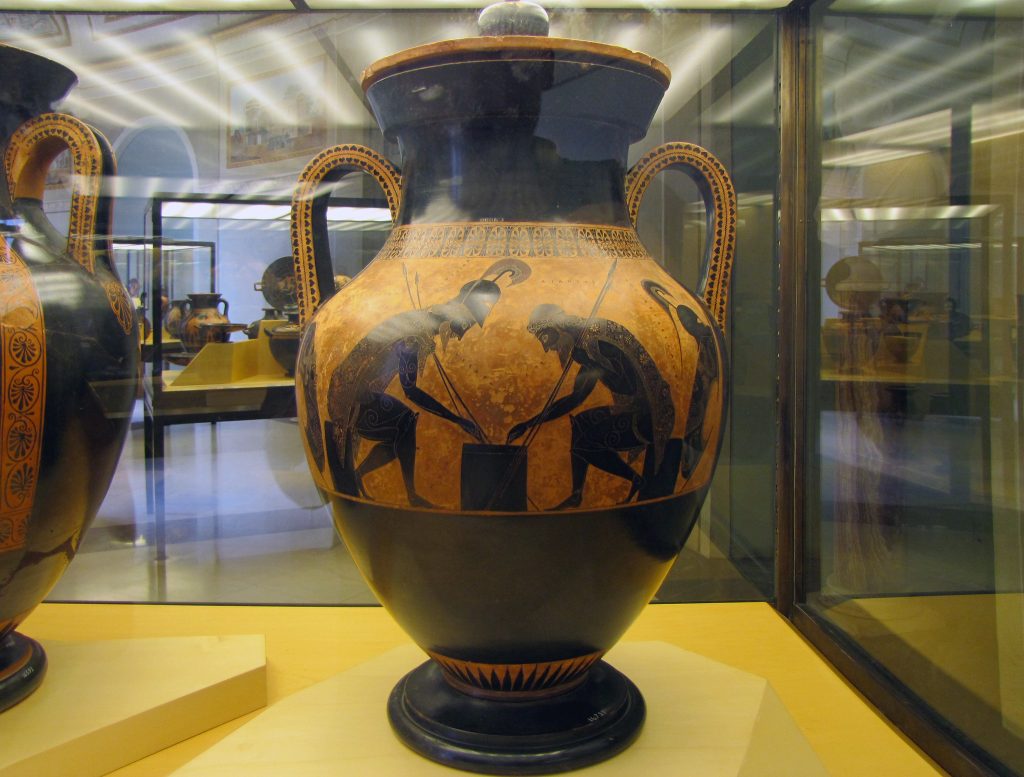
Achilles and Ajax, heroes of the Trojan War, break from battle to play a friendly game that hints at a tragic future. This is a transcript of a conversation conducted at the Etruscan Museum, Vatican, Rome. To watch the video: https://www.youtube.com/watch?v=k2fdtepbkz8.
Steven: We’re in the Etruscan Museum in the Vatican Museums in Rome and we’re looking at my favorite pot in the entire world.
Beth: I can see why it’s your favorite pot. It seems to almost glow.
Steven: The thing that makes it so fabulous is we have these two heroes and we have a very simple image, but it’s giving us so much information.
Beth: The heroes are Achilles on the left and Ajax on the right, two of the great Greek heroes featured in Homer’s Iliad and Exekias, the potter, who signed only two pots as the potter and the painter, has identified these two figures by including their names above them, but he’s also telling us what’s happening between the two: Achilles on the left is saying the word “four.”
Steven: You can see “tesara.”Beth: And on the right, we see Ajax, saying “three.”
Steven: “Tri.”
Beth: We know immediately that Achilles is winning the game that they’re playing.
Steven: But this is, of course, a metaphor for the way that this myth will unfold.

Beth: On either side we see their shields. Achilles still has his helmet on, although Ajax has taken his off. So: a moment of relaxation between battles.
Steven: They’re on the battlefield of Troy, but Exekias has given us even more information than this, not simply the rolls of the dice, but in a larger sense, their fate. Look at the way, for example, that while both figures are hunched over and clearly focused on the game at hand–and remember, these two men are really close friends, so there’s an intimacy here, brotherhood—nevertheless, Achilles, who has the higher roll, is holding his spears loosely. You can see the way the points are actually separating. At the bottom, you can see from the lines, they’re not as parallel. But look at the figure on the right, Ajax, whose spears are held in a more parallel way, so that we know that he’s actually clenching with his fist, he’s tense.
Beth: I even sense a little bit of that tension in his brow.
Steven: That’s right. If you look at the brow really closely, you can see that Achilles has a single incised line to represent his eyebrow, but Ajax has a double line and it is a subtle clue that perhaps there’s a little bit of tension there. One other detail that can be easily seen, although it’s really subtle: look at the feet of both figures. Achilles, again, is relaxed. His heel is on the ground line, but Ajax, his heel is picked up ever so slightly, so you can see just a little bit of light underneath it, which means his calf is engaged, those muscles are tense, his body is tense.
Beth: He’s also a little bit more hunched over. His head is a little bit lower than that of his friend Achilles. That does seem to mean something wider than just this board game.
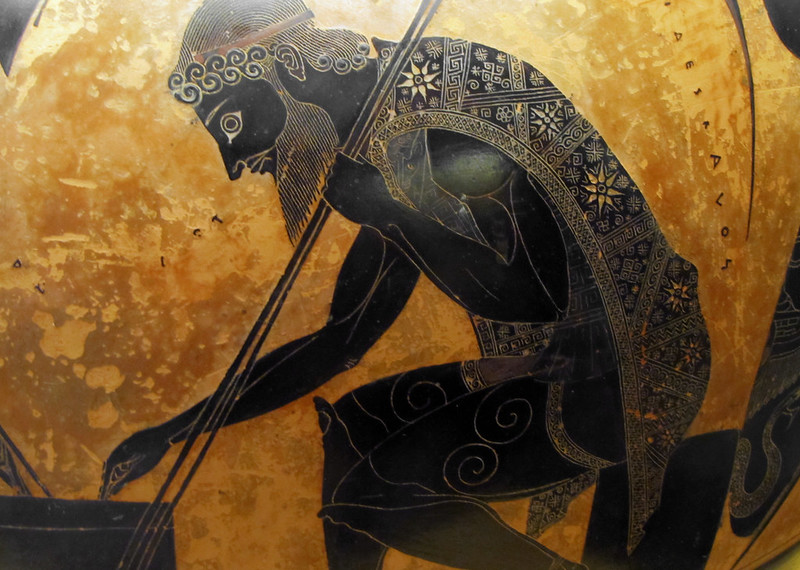
Steven: Anybody who was looking at this pot in the ancient world would have known the story of Ajax and Achilles that Homer tells, as you said, in the Iliad. Achilles is a great hero. In fact, as a child, his mother dipped him in the river Styx, which had the magical quality of making him invincible. It’s just that she held him by his heel, so his heel was not protected and ultimately, he would be killed by an arrow that hits him there.Beth: Hence the term that we use often of someone’s Achilles heel, that is, their vulnerable spot.
Steven: Nevertheless, Achilles will die a great hero. Ajax will have a more complicated fate. He will outlive Achilles, and he will carry his great friend off the battlefield, but ultimately, he’ll be in a battle for Achilles’ armor.
Beth: Achilles had very special armor, which had been made by thegod Hephaestus, the god of the forge.
Steven: Two people would want that armor, and they would both give speeches to convince judges as to who should get the armor, but Ajax, although he was much closer to Achilles, would lose the contest, have a bad moment where he slayed a bunch of Greeks, and ultimately, would kill himself on his own sword. Humiliation at the end of his life.
Beth: It’s really interesting to think about this as an ancient Greek viewer who knows that whole story and what will unfold for both of these heroes, but the story is one thing and the way that Exekias, the potter, has represented this moment and these two figures with so much nobility, with such fine detail in the shape of a vase, which is so elegant, is something else.
Steven: Exekias really was the great master of Attic black-figure vase painting. These are black figures, they are silhouettes. If you look closely, the decorative forms is mostly incised with a needle.
Beth: And the black surface is like paint, but it’s not quite paint.
Steven: This is slipware. Now, the Greeks didn’t have the technology to get kiln ovens hot enough to vitrify, that is to create true glazes, the way ceramics do now. What they would do instead is they would take very fine particles of clay, suspend them in water, and use those as a kind of paint. Depending on the amount of oxygen that they allowed into a kiln, they could turn it black or red. They would paint the surface with this slip and then they would burnish it. That is, they would take a very smooth surface, imagine the back of a spoon, and they would rub it back and forth so you get this surface that is really glossy and it almost looks like glaze.
Beth: When I look closely at the decorative borders on the handles or the decorative border just above the frieze of figures, I can see beautiful detail and the almost three-dimensional form of the slip is almost raised in areas, so it catches the light.
Steven: The Greeks did often use a syringe to paint the finest lines onto the surface, so one could imagine almost decorating a cake. You have a kind of syringe and you have the icing and it leaves a kind of bead that is raised against the surface and at a much finer level, that’s what we’re seeing here.
Beth: So Exekias is a master. His pots stand out in so many ways in their shape, in the painting, in the detail, in the drama that he was able to convey.
Steven: Certainly the Etruscans thought that was the case, because they must have spent a good deal of money importing this pot from Greece, across the Mediterranean, all the way to the Italian peninsula where they lived. So many of the great pots from ancient Greece are actually buried in Etruscan tombs. They were imported. The Greeks did a tremendous business exporting such pots, but Exekias was one of the great masters.
Sculpture in the Archaic Period

Sculpture in the Archaic Period developed rapidly from its early influences, becoming more natural and showing a developing understanding of the body, specifically the musculature and the skin. Close examination of the style’s development allows for precise dating.
Most statues were commissioned as memorials and votive offerings or as grave markers, replacing the vast amphora (two-handled, narrow-necked jars used for wine and oils) and kraters (wide-mouthed vessels) of the previous periods, yet still typically painted in vivid colors.
Kouroi
Kouroi statues (singular, kouros), depicting idealized, nude male youths, were first seen during this period. Carved in the round , often from marble, kouroi are thought to be associated with Apollo; many were found at his shrines and some even depict him. Emulating the statues of Egyptian pharaohs, the figure strides forward on flat feet, arms held stiffly at its side with fists clenched. However, there are some importance differences: kouroi are nude, mostly without identifying attributes and are free-standing.
Early kouroi figures share similarities with Geometric and Orientalizing sculpture, despite their larger scale. For instance, their hair is stylized and patterned, either held back with a headband or under a cap. The New York Kouros strikes a rigid stance and his facial features are blank and expressionless. The body is slightly molded and the musculature is reliant on incised lines .
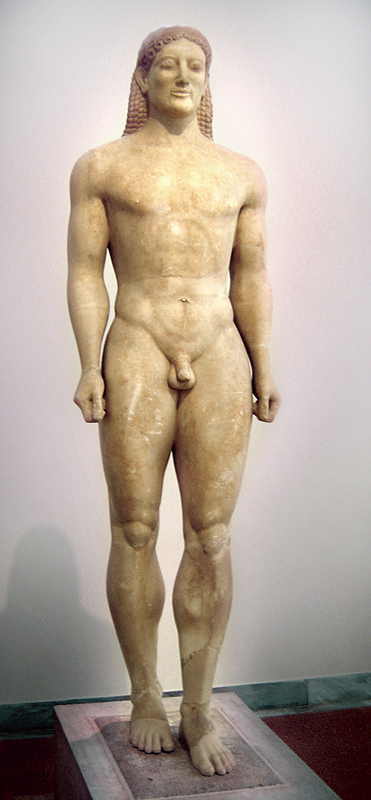
As kouroi figures developed, they began to lose their Egyptian rigidity and became increasingly naturalistic. The kouros figure of Kroisos, an Athenian youth killed in battle, still depicts a young man with an idealized body. This time though, the body’s form shows realistic modeling.
The muscles of the legs, abdomen, chest and arms appear to actually exist and seem to function and work together. Kroisos’s hair, while still stylized, falls naturally over his neck and onto his back, unlike that of the New York Kouros, which falls down stiffly and in a single sheet. The reddish appearance of his hair reminds the viewer that these sculptures were once painted.
Archaic Smile
Kroisos’s face also appears more naturalistic when compared to the earlier New York Kouros. His cheeks are round and his chin bulbous; however, his smile seems out of place. This is typical of this period and is known as the Archaic smile. It appears to have been added to infuse the sculpture with a sense of being alive and to add a sense of realism.
Kore
A kore (plural korai) sculpture depicts a female youth. Whereas kouroi depict athletic, nude young men, the female korai are fully-clothed, in the idealized image of decorous women. Unlike men—whose bodies were perceived as public, belonging to the state—women’s bodies were deemed private and belonged to their fathers (if unmarried) or husbands.
However, they also have Archaic smiles, with arms either at their sides or with an arm extended, holding an offering. The figures are stiff and retain more block-like characteristics than their male counterparts. Their hair is also stylized, depicted in long strands or braids that cascade down the back or over the shoulder.
The Peplos Kore (c. 530 BCE) depicts a young woman wearing a peplos, a heavy wool garment that drapes over the whole body, obscuring most of it. A slight indentation between the legs, a division between her torso and legs, and the protrusion of her breasts merely hint at the form of the body underneath.

Remnants of paint on her dress tell us that it was painted yellow with details in blue and red that may have included images of animals. The presence of animals on her dress may indicate that she is the image of a goddess, perhaps Artemis, but she may also just be a nameless maiden.
Later korai figures also show stylistic development, although the bodies are still overshadowed by their clothing. The example of a Kore (520–510 BCE) from the Athenian Acropolis shows a bit more shape in the body, such as defined hips instead of a dramatic belted waistline, although the primary focus of the kore is on the clothing and the drapery. This kore figure wears a chiton (a woolen tunic), a himation (a lightweight undergarment), and a mantle (a cloak). Her facial features are still generic and blank, and she has an Archaic smile. Even with the finer clothes and additional adornments such as jewelry, the figure depicts the idealized Greek female, fully clothed and demure.
Pedimental Sculpture: The Temple of Artemis at Corfu
This sculpture, initially designed to fit into the space of the pediment, underwent dramatic changes during the Archaic period, seen later at Aegina. The west pediment at the Temple of Artemis at Corfu depicts not the goddess of the hunt, but the Gorgon Medusa with her children; Pegasus, a winged horse; and Chrysaor, a giant wielding a golden sword surrounded by heraldic lions.
Medusa faces outwards in a challenging position, believed to be apotropaic (warding off evil). Additional scenes include Zeus fighting a Titan, and the slaying of Priam, the king of Troy, by Neoptolemos. These figures are scaled down in order to fit into the shrinking space provided in the pediment.
Pedimental Sculpture: The Temple of Aphaia at Aegina
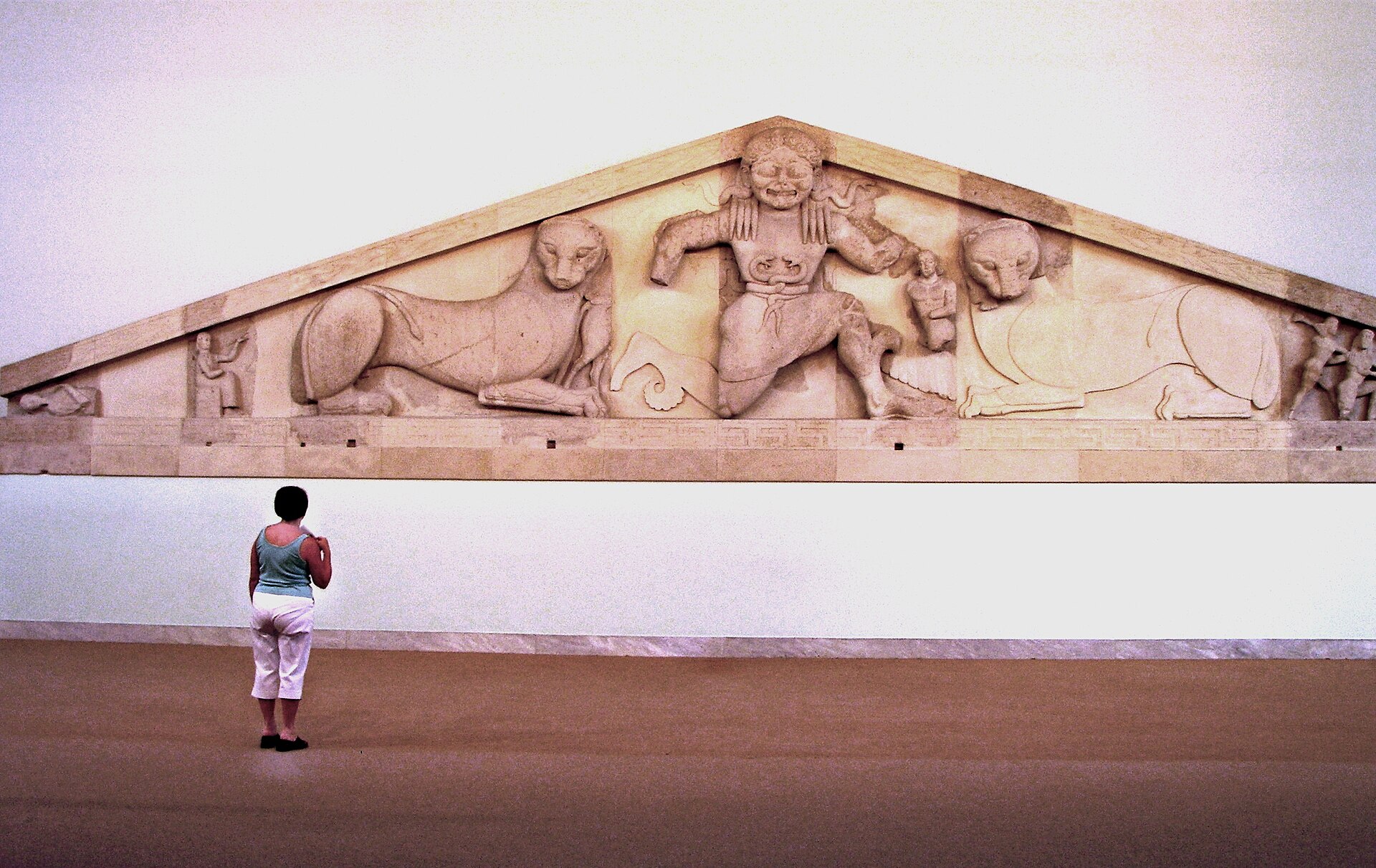
Sculpted approximately one century later, the pedimental sculptures on the Temple of Aphaia at Aegina gradually grew more naturalistic than their predecessors at Corfu. The dying warrior on the west pediment (c. 490 BCE) is a prime example of Archaic sculpture. The male warrior is depicted nude, with a muscular body that shows the Greeks’ understanding of the musculature of the human body. His hair remains stylized with round, geometric curls and textured patterns.
However, despite the naturalistic characteristics of the body, the body does not seem to react to its environment or circumstances. The warrior props himself up with an arm, and his whole body is tense, despite the fact that he has been struck by an arrow in his chest. His face, with its Archaic smile, and his posture conflict with the reality that he is dying.
Aegina: Transition between Styles

The dying warrior on the east pediment (c. 480 BCE) marks a transition to the new Classical style. Although he bears a slight Archaic smile, this warrior actually reacts to his circumstances. Nearly every part of him appears to be dying.
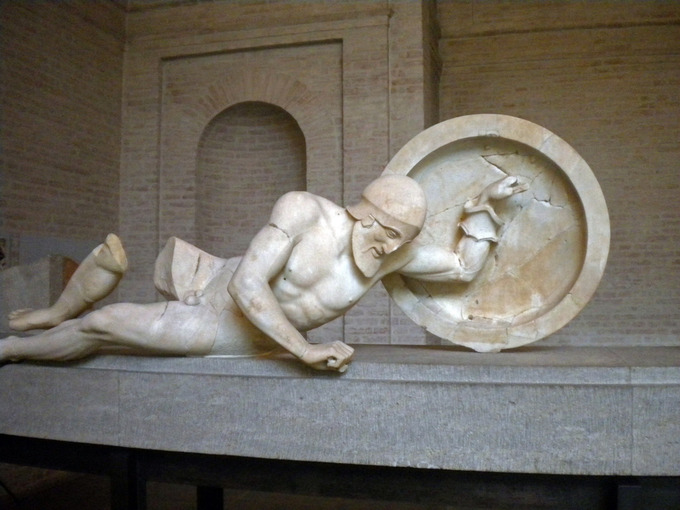
Instead of propping himself up on an arm, his body responds to the gravity pulling on his dying body, hanging from his shield and attempting to support himself with his other arm. He also attempts to hold himself up with his legs, but one leg has fallen over the pediment’s edge and protrudes into the viewer’s space. His muscles are contracted and limp, depending on which ones they are, and they seem to strain under the weight of the man as he dies.
Statue of a woman (Lady of Auxerre) A CONVERSATION
By Dr. Beth Harris and Dr. Steven Zucker

This is the transcript of a conversation conducted in the Musée du Louvre, Paris. To watch the video: https://youtu.be/XoEVvoc2PlM
Steven: We’re in the Louvre, in Paris, and we’re looking at a small, free-standing sculpture—a figure that’s often known as the Lady of Auxerre.
Beth: This is a Greek figure, likely from the island of Crete, but she was found, hence her title, in the French city of Auxerre, in the basement of a municipal museum. So we really don’t know about her findspot (the location where the object was originally excavated).
Steven: There’s some conjecture that she may have come originally from a cemetery in Crete, which would mean that she was a funerary sculpture, but we’re not sure. It’s possible that she was a votive figure, that is, a figure that was meant to honor the gods. And some scholars have even suggested that she might be a goddess herself.
Beth: This period, in the seventh century, is referred to as the Daedalic. And that name comes from the legendary sculptor Daedalus, who was said to be from the island of Crete.
Steven: This is a stylistic period that comes before the Archaic and parallels the Orientalizing style in ceramic decoration.
Beth: And in so many ways, she really does seem to prefigure the Archaic figures that we call kore: freestanding female figures that were sometimes representations of goddesses, sometimes votive figures (offerings to the gods)… This columnar (resembling a column) female figure who is very frontally oriented.
Steven: And abstracted. Her head is flattened, the face is relatively flat, the eyes are almond shaped.
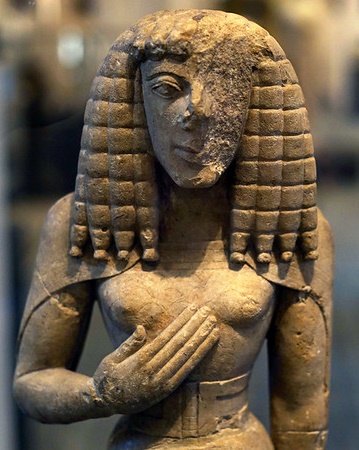
Beth: “Flattened” is a good word here, because the front of her body appears flattened–although we do see her breasts—and even her hair has a flattened effect on either side of her face, and the top of her head also seems flattened.
Steven: But these are not unique characteristics to this sculpture. This is consistent with other sculptures of this period and of this area.
Beth: This is carved out of limestone. We’re used to seeing Greek sculptures as white marble, but we now know that these sculptures were generally brightly painted.
Steven: One of the most delicate aspects is the incising (lines cut into the stone). And we can see it most obviously in the square patterns in the front of her dress, but you can also make it out in the wrap that she wears around her shoulders and that move down one side of her arm.
Beth: And you can also make it out in the very wide belt that she wears and even in that collar underneath the shawl. What strikes me is that this is a very idealized figure; this is not meant to be a portrait of the deceased person whose grave this may have marked. This is a figure shown, very much like later Greek figures in the Archaic and Classical period, at the prime of life. She is beautiful, she’s young, she looks strong and healthy. Her waist is very narrow… She’s very feminine.
Steven: And the corners of her mouth are upturned in an expression that is sometimes referred to as the “Archaic smile,” even though this is before the Archaic period. Some art historians have conjectured that this may be an expression of well-being, of happiness, or perhaps a kind of transcendence. She feels so formal. Her feet are together.

Beth: That hand, in front…the other hand, that seems almost glued to the side of her body. But, unlike, earlier Egyptian figures, she’s freed from the stone. We have space between her body and her arms, which is an important part of this very early Greek tradition, which we’ll see in Archaic Greek art. And despite all the abstraction in her body that we just talked about, there’s something very lifelike about her, especially in her face. And I think that would have been even more true when she was painted; if we imagine the pink of her lips, or painted pupils in her eyes, or her hair painted brown…
Steven: One of the reasons that a figure like this fascinates art historians is because we know what happens next. She stands at the beginning of this long history of Greek sculpture, which reaches levels of brilliance that we’ve admired for thousands of years after. We’re seeing an early figure here, but one that, with all of the hindsight that we have, offers extraordinary promise.
The Greek Early Classical Period
Architecture & Sculpture
Temple of Zeus at Olympia
The Temple of Zeus at Olympia is a colossal ruined temple in the center of the Greek capital Athens that was dedicated to Zeus, king of the Olympian gods. Its plan is similar to that of the Temple of Aphaia at Aegina.

It is hexastyle, with six columns across the front and back and 13 down each side. It has two columns directly connected to the walls of the temple, known as in antis, in front of both the entranceway (pronaos ) and the inner shrine ( opisthodomos ). Like the Temple of Aphaia, there are two, two-story colonnades of seven columns on each side of the inner sanctuary (naos).The pedimental figures are depicted in the developing Classical style with naturalistic yet overly muscular bodies. Most of the figures are shown with the expressionless faces of the Severe style.

The figures on the east pediment await the start of a chariot race, and the whole composition is still and static . A seer, however, watches it in horror as he foresees the death of Oenomaus. This level of emotion would never be present in Archaic statues and it breaks the Early Classical Severe style, allowing the viewer to sense the forbidding events about to happen. The level of emotion on the seer’s face would never be present in Archaic statues and it breaks the Early Classical Severe style, allowing the viewer to sense the forbidding events about to happen.
Unlike the static composition of the eastern pediment, the Centauromachy (below) on the western pediment depicts movement that radiates out from its center. The centaurs, fighting men, and abducted women struggle and fight against each other, creating tension in another example of an early portrayal of emotion. Most figures are depicted in the Severe style. However, some, including a centaur, have facial features that reflect their wrath and anger.
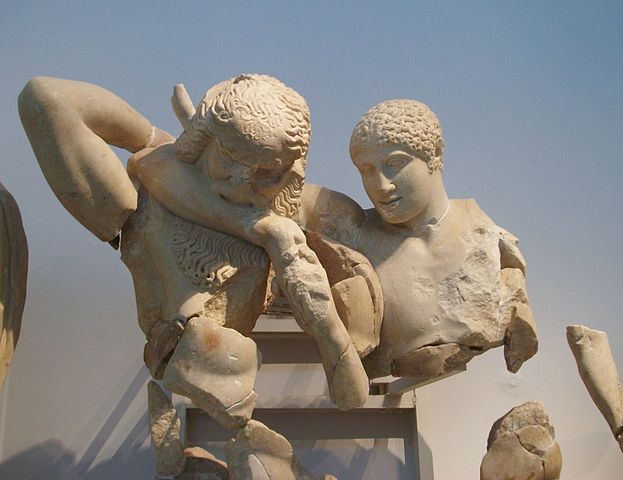
The twelve metopes over the pronaos and opisthodomos depict scenes from the twelve labors of Herakles. Like the development in pedimental sculpture, the reliefs on the metopes display the Early Classical understanding of the body. Herakles’ body is strong and idealized, yet it has a level of naturalism and plasticity that increases the liveliness of the reliefs.

The scenes depict varying types of compositions. Some are static with two or three figures standing rigidly, while others, such as Herakles and the Cretan Bull, convey a sense of liveliness through their diagonal composition and overlapping bodies.

Kritios Boy
A slightly smaller-than-life statue known as the Kritios Boy was dedicated to Athena by an athlete and found in the Perserchutt of the Athenian Acropolis. Its title derives from a famous artist to whom the sculpture was once attributed.
The marble statue is a prime example of the Early Classical sculptural style and demonstrates the shift away from the stiff style seen in Archaic kouroi. The torso depicts an understanding of the body and plasticity of the muscles and skin that allows the statue to come to life.
Part of this illusion is created by a stance known as contrapposto. This describes a person with his or her weight shifted onto one leg, which creates a shift in the hips, chest, and shoulders to create a stance that is more dramatic and naturalistic than a stiff, frontal pose. This contrapposto position animates the figure through the relationship of tense and relaxed limbs.
However, the face of the Kritios Boy is expressionless, which contradicts the naturalism seen in his body. This is known as the Severe style. The blank expressions allow the sculpture to appear less naturalistic, which creates a screen between the art and the viewer. This differs from the use of the Archaic smile (now gone), which was added to sculpture to increase their naturalism. However, the now empty eye sockets once held inlaid stone to give the sculpture a lifelike appearance.
Kritios Boy: A Conversation
By Dr. Beth Harris and Dr. Steven Zucker
This the transcript of a conversation conducted at the Acropolis in Athens. To watch the video: https://youtu.be/Q5IWDhXtsmE
Steven: We’re in the new Acropolis museum, in Athens, looking at the Kritios Boy.
Beth: We’re in the very late archaic period. Some call this the severe style. We might even call this early classical.
Steven: It’s really this transition between the late archaic and the early classical. The sculpture is such a great embodiment of that.
Beth: It allows us to see the transition between the archaic kouros, and the much more naturalistic, movement-filled figures that we find on the Parthenon, for example, on the frieze or in the metopes.
Steven: This sculpture was probably broken originally when the Persians invaded Athens and desecrated the Acropolis. This was a huge blow to the Greeks, and when they finally recovered this territory, they took the sculptures that had been destroyed, and they buried them. So it’s ironic that the reason that these sculptures are preserved is in part because they were destroyed, but to make the story even more complicated, before the Greeks had been defeated by the Persians, they had an earlier victory at Marathon.
Beth: Where an overwhelming force of Persians was defeated.
Steven: That first victory by the Greeks, over the Persians, is important to understand, in relationship to the sculpture, because some art historians have suggested that the new-found naturalism that we see in the sculpture is a result of the new sense of self; the new sense of self-determination, that came in the wake of the victory over the Persians.
Beth: And a sense of Athens as the leader among the Greek city-states, who united against the Persians.
Steven: So like the earlier kouros figures, this is marble; it’s a standing nude; he’s relatively still, although there is this potential for movement.
Beth: With the kouros figures, we had a figure that was both standing still and moving simultaneously, but we have incipient movement. Movement about to take place. We have a sense of process, and I think it’s that unfolding of time, that makes this figure seem so much a part of our world, instead of the timeless world of the kouros.
Steven: The kouros figures were depicted as stick figures. There were mechanical joints, that were suggested, but did not really exist.
Beth: Didn’t really work.
Steven: That’s right. There was no way for those figures to actually move, whereas this figure, the much more naturalistic renderings of the volumes of the body; the understanding of the musculature; the understanding of the bone structure; and especially the transitions from one part of the body to the next, make the potential for movement believable.
Beth: Although we don’t see the feet, and the right side, we don’t see the calf, there is a sense that this figure is standing in a pose that art historians call contrapposto. That is, his weight is shifted onto one leg, and here’s the important part; as a result, other things happen within the body, so that one shift in one part of the body affects the rest of the body, so the body acts in unison.
Steven: We can see that very clearly with the knees. The weight-bearing knee is higher than the free-leg knee, and that’s because that knee droops down a little bit. The axis of the hips are no longer aligned. The weight-bearing leg has a hip that juts upward, into the torso, where the free leg, the hip hands down.
Beth: The shoulder above the weight-bearing leg actually drops down slightly, and that compresses the torso in between. His lifelikeness is carried into the head, which shifts a little bit, so we don’t have that strict frontality that we saw in the kouroi. The symmetry of the body is broken. In actuality human beings are never symmetrical, right? Our bodies move and shift.
Steven: That’s why the kouroi seem so artificial.
Beth: Exactly; they seem transcendent and timeless, but because the Kritios Boy is asymmetrical, we have a sense of his engagement with the world. Gone is that archaic smile, that seems to transcend reality, but one of the really interesting things about the Kritios Boy is, if we look from the side, we see an arch in his back, and there’s a sense that he’s moving forward, and holding himself back at the same time. He’s a bit of a tease.
Steven: He’s in a very relaxed pose.
Beth: We should mention that the Greeks had started to make bronze sculptures just before this, and bronze allowed artists to create sculptures with limbs more separated from the torso, or limbs lifted into space.
Steven: And you can see why that could be tricky in marble. In fact this figure has lost its leg, and it’s lost its arms. On his left hip you can still see a fragment of the strut or bridge that would have helped support the arm that would have been next to it. That also lets us know that the arm really was at his sides, very much like a traditional kouros.
Beth: We see the desire on the part of the Greeks, on the part of this artist, to create a sculpture that’s more open, where the limbs and the torso are more separated from one another, but in marble that’s really hard to do.
Steven: One more point about the interest in bronze. Unlike so much marble sculpture, here we have eyes that have been hollowed out. They would have been inset, probably, with glass paste eyes, that would have been very lifelike, and that’s a technique that was commonly used in bronze. In traditional marble sculptures, you actually have the eye as part of the solid piece of marble, and they would have just been painted. There is this interesting reference to the technique of bronze casting, even here in a marble sculpture, and I should mention that the reason we call the Kritios Boy is because the Kritios sculptor was an important sculptor in bronze at this time, of which this is very stylistically similar.
In the entire body, we’ve moved away from the linear representation of symbols of the body, and we now have these smooth, beautiful, volumes, that represent this Greek ideal of the athletic male youth.
Beth: That represented the peak of human achievement, and also the qualities of the divine.
Riace Warriors

The Riace Warriors (also referred to as the Riace bronzes or Bronzi di Riace) are two life-size Greek bronze statues of naked, bearded warriors. The statues were discovered by Stefano Mariottini in the Mediterranean Sea just off the coast of Riace Marina, Italy, on August 16, 1972. The statues are currently housed in the Museo Nazionale della Magna Grecia in the Italian city of Reggio Calabria. The statues are commonly referred to as “Statue A” and “Statue B” and were originally cast using the lost-wax technique.
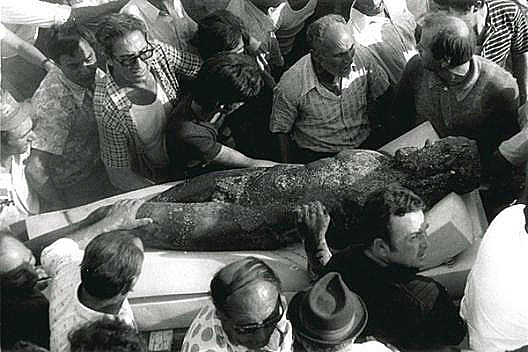
Statue A

Statue A stands 198 centimeters tall and depicts the younger of the two warriors. His body exhibits a strong contrapposto stance, with the head turned to his right. Attached elements have been lost – most likely a shield and a spear; his now-lost helmet atop his head may have been crowned by a wreath. The warrior is bearded, with applied copper detail for the lips and the nipples. Inset eyes also survive for
Statue A. The hair and beard have been worked in an elaborate fashion, with exquisite curls and ringlets.
Statue B
Statue B depicts an older warrior and stands 197 centimeters tall. A now-missing helmet likely was perched atop his head. Like Statue A, Statue B is bearded and in a contrapposto stance, although the feet of Statue B and set more closely together than those of Statue A.
Severe style
The Severe or Early Classical style describes the trends in Greek sculpture between c. 490 and 450 B.C.E. Artistically this stylistic phase represents a transition from the rather austere and static Archaic style of the sixth century B.C.E. to the more idealized Classical style. The Severe style is marked by an increased interest in the use of bronze as a medium as well as an increase in the characterization of the sculpture, among other features.
Interpretation and chronology

The chronology of the Riace warriors has been a matter of scholarly contention since their discovery. In essence there are two schools of thought—one holds that the warriors are fifth century B.C.E. originals that were created between 460 and 420 B.C.E., while another holds that the statues were produced later and consciously imitate Early Classical sculpture. Those that support the earlier chronology argue that Statue A is the earlier of the two pieces. Those scholars also make a connection between the warriors and the workshops of famous ancient sculptors. For instance, some scholars suggest that the sculptor Myron crafted Statue A, while Alkamenes created Statue B. Additionally, those who support the earlier chronology point to the Severe Style as a clear indication of an Early Classical date for these two masterpieces.
The art historian B. S. Ridgway presents a dissenting view, contending that the statues should not be assigned to the fifth century B.C.E., arguing instead that they were most likely produced together after 100 B.C.E. Ridgway feels that the statues indicate an interest in Early Classical iconography during the Hellenistic period.

In terms of identifications, there has been speculation that the two statues represent Tydeus (Statue A) and Amphiaraus (Statue B), two warriors from Aeschylus’ tragic play, Seven Against Thebes (about Polyneices after the fall of his father, King Oedipus), and may have been part of a monumental sculptural composition. A group from Argos described by Pausanias (the Greek traveler and writer) is often cited in connection to this conjecture: “A little farther on is a sanctuary of the Seasons. On coming back from here you see statues of Polyneices, the son of Oedipus, and of all the chieftains who with him were killed in battle at the wall of Thebes…” (Pausanias, Description of Greece 2.20.5).
The statues have lead dowels installed in their feet, indicating that they were originally mounted on a base and installed as part of some sculptural group or other. The art historian Carol Mattusch argues that not only were they found together, but that they were originally installed—and perhaps produced—together in antiquity.
Polykleitos, Doryphoros (Spear-Bearer)
by Dr. Beth Harris and Dr. Steven Zucker
For the ancient Greeks, the human body was perfect. Explore this example of the mathematical source of ideal beauty.

Roman copies of ancient Greek art
When we study ancient Greek art, so often we are really looking at ancient Roman art, or at least their copies of ancient Greek sculpture (or paintings and architecture for that matter).
Basically, just about every Roman wanted ancient Greek art. For the Romans, Greek culture symbolized a desirable way of life—of leisure, the arts, luxury and learning.
The popularity of ancient Greek art for the Romans
Greek art became the rage when Roman generals began conquering Greek cities (beginning in 211 B.C.E.), and returned triumphantly to Rome not with the usual booty of gold and silver coins, but with works of art. This work so impressed the Roman elite that studios were set up to meet the growing demand for copies destined for the villas of wealthy Romans. The Doryphoros was one of the most sought after, and most copied, Greek sculptures.
Bronze versus marble
For the most part, the Greeks created their free-standing sculpture in bronze, but because bronze is valuable and can be melted down and reused, sculpture was often recast into weapons. This is why so few ancient Greek bronze originals survive, and why we often have to look at ancient Roman copies in marble (of varying quality) to try to understand what the Greeks achieved.
Why sculptures are often incomplete or reconstructed
To make matter worse, Roman marble sculptures were buried for centuries, and very often we recover only fragments of a sculpture that have to be reassembled. This is the reason you will often see that sculptures in museums include an arm or hand that are modern recreations, or that ancient sculptures are simply displayed incomplete.
The Doryphoros (Spear-Bearer) in the Naples museum (image above) is a Roman copy of a lost Greek original that we think was found, largely intact, in the provincial Roman city of Pompeii.1
The canon
The idea of a canon, a rule for a standard of beauty developed for artists to follow, was not new to the ancient Greeks. The ancient Egyptians also developed a canon. Centuries later, during the Renaissance, Leonardo da Vinci investigated the ideal proportions of the human body with his Vitruvian Man.
Polykleitos’s idea of relating beauty to ratio was later summarized by Galen, writing in the second century,
Beauty consists in the proportions, not of the elements, but of the parts, that is to say, of finger to finger, and of all the fingers to the palm and the wrist, and of these to the forearm, and of the forearm to the upper arm, and of all the other parts to each other.
To watch Dr. Beth Harris & Dr. Steven Zucker discuss the Doryphoros: https://youtu.be/EAR9RAMg9NY
The Athenian Acropolis
The study of Classical-era architecture is dominated by the study of the construction of the Athenian Acropolis and the development of the Athenian agora. The Acropolis is an ancient citadel located on a high, rocky outcrop above and at the center of the city of Athens. It contains the remains of several ancient buildings of great architectural and historic significance.
The word acropolis comes from the Greek words άκρο (akron, meaning edge or extremity) and πόλη (polis, meaning city). Although there are many other acropolises in Greece, the significance of the Acropolis of Athens is such that it is commonly known as The Acropolis without qualification.

The Acropolis has played a significant role in the city from the time that the area was first inhabited during the Neolithic era. While there is evidence that the hill was inhabited as far back as the fourth millennium BCE, in the High Classical Period it was Pericles (c. 495–429 BCE) who coordinated the construction of the site’s most important buildings, including the Parthenon, the Propylaea, the Erechtheion, and the temple of Athena Nike.
The buildings on the Acropolis were constructed in the Doric and Ionic orders, with dramatic reliefs adorning many of their pediments, friezes, and metopes.
In recent centuries, its architecture has influenced the design of many public buildings in the Western hemisphere.
Early History

Archaeological evidence shows that the acropolis was once home to a Mycenaean citadel. The citadel’s Cyclopean walls defended the Acropolis for centuries, and still remains today. The Acropolis was continually inhabited, even through the Greek Dark Ages when Mycenaean civilization fell.
It is during the Geometric period that the Acropolis shifted from being the home of a king to being a sanctuary site dedicated to the goddess Athena, whom the people of Athens considered their patron. The Archaic -era Acropolis saw the first stone temple dedicated to Athena, known as the Hekatompedon (Greek for hundred-footed).
This building was built from limestone around 570 to 550 BCE and was a hundred feet long. It has the original home of the olive-wood statue of Athena Polias, known as the Palladium, that was believed to have come from Troy.
In the early fifth century the Persians invaded Greece, and the city of Athens—along with the Acropolis—was destroyed, looted, and burnt to the ground in 480 BCE. Later the Athenians, before the final battle at Plataea, swore an oath that if they won the battle—that if Athena once more protected her city—then the Athenian citizens would leave the Acropolis as it is, destroyed, as a monument to the war. The Athenians did indeed win the war, and the Acropolis was left in ruins for thirty years.
Periclean Revival
It was immediately following the Persian war that the Athenian general and statesman Pericles funded an extensive building program on the Athenian Acropolis. Despite the vow to leave the Acropolis in a state of ruin, the site was rebuilt, incorporating all the remaining old materials into the spaces of the new site.
The building program began in 447 BCE and was completed by 415 BCE. It employed the most famous architects and artists of the age and its sculpture and buildings were designed to complement and be in dialog with one another.
The Propylaea

Mnesicles designed the Propylaea (437–432 BCE), the monumental gateway to the Acropolis. It funneled all traffic to the Acropolis onto one gently sloped ramp. The Propylaea created a massive screen wall that was impressive and protective as well as welcoming.
It was designed to appear symmetrical but, in reality, was not. This illusion was created by a colonnade of paired columns that wrapped around the gateway. The southern wing incorporated the original Cyclopean walls from the Mycenaean citadel. This space was truncated but served as dining area for feasting after a sacrifice.
The northern wing was much larger. It was a pinacoteca , where large panel paintings were hung for public viewing. The order of the Propylaea and its columns are Doric, and its decoration is simple—there are no reliefs in the metopes and pediment.
Upon entering the Acropolis from the Propylaea, visitors were greeted by a colossal bronze statue of Athena Promachos (c. 456 BCE), designed by Phidias. Accounts and a few coins minted with images of the statue allow us to conclude that the bronze statue portrayed a fearsome image of a helmeted Athena striding forward, with her shield at her side and her spear raised high, ready to strike.
The Erechtheion
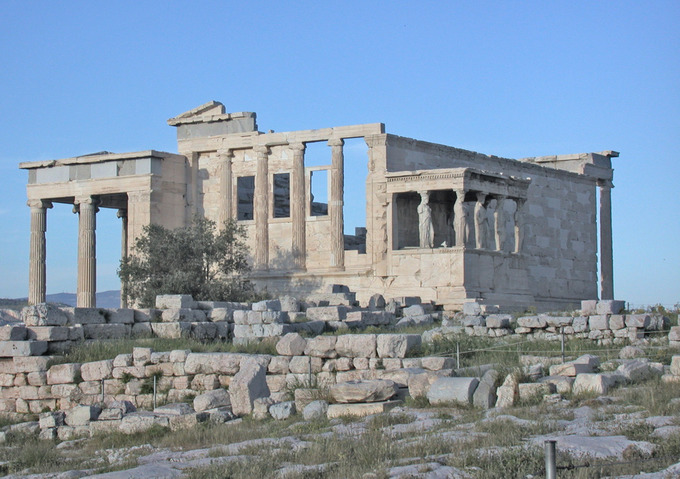
The Erechtheion (421–406 BCE), designed by Mnesicles, is an ancient Greek temple on the north side of the Acropolis. Scholars believe the temple was built in honor of the legendary king Erechtheus.It was built on the site of the Hekatompedon and over the megaron of the Mycenaean citadel. The odd design of the temple results from the site’s topography and the temple’s incorporation of numerous ancient sites.
The temple housed the Palladium, the ancient olive-wood statue of Athena. It was also believed to be the site of the contest between Athena and Poseidon, and so displayed an olive tree, a salt-water well, and the marks from Poseidon’s trident to the faithful.
Shrines to the mythical kings of Athens, Cecrops and Erechteus—who gives the temple its name—were also found within the Erechtheion. Because of its mythic significance and its religious relics, the Erechtheion was the ending site of the Panathenaic festival, when the peplos on the olive-wood statue of Athena was annually replaced with new clothing with due pomp and ritual.
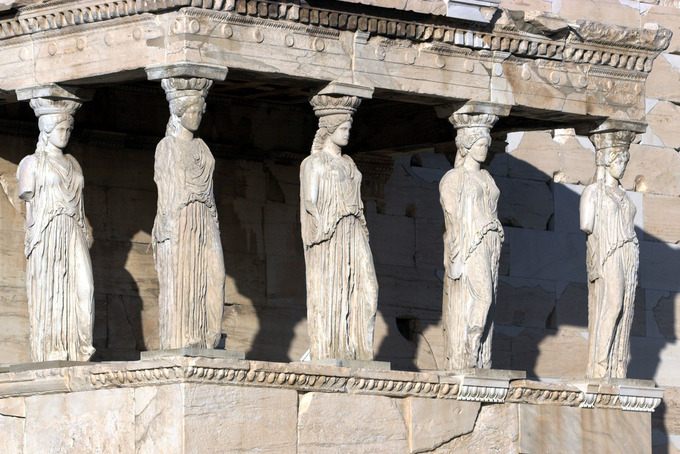
A porch on the south side of the Erechtheion is known as the Porch of the Caryatids, or the Porch of the Maidens. Six, towering, sculpted women (caryatids) support the entablature. The women replace the columns, yet look columnar themselves. Their drapery, especially over their weight-bearing leg, is long and linear, creating a parallel to the fluting on an Ionic column.
Although they stand in similar poses, each statue has its own stance, facial features, hair, and drapery. They carry egg-and-dart capitals on their heads, much as women throughout history have carried baskets. Between their heads and this capital is a sculpted cushion, which gives the appearance of softening the load of the weight of the building.
The sculpted columnar form of the caryatids is named after the women of the town of Kayrai, a small town near and allied to Sparta. At one point during the Persian Wars the town betrayed Athens to the Persians. In retaliation, the Athenians sacked their city, killing the men and enslaving the women and children. Thus, the caryatids depicted on the Acropolis are symbolic representations of the full power of Athenian authority over Greece and the punishment of traitors.
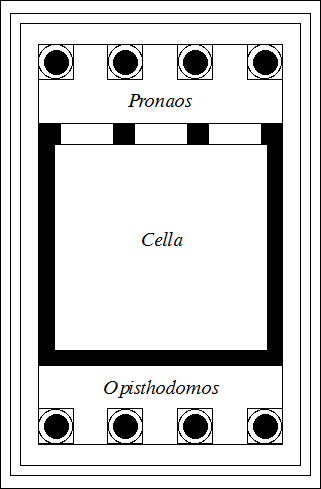
The Temple of Athena Nike
The Temple of Athena Nike (427–425 BCE), designed by Kallikrates in honor of the goddess of victory, stands on the parapet of the Acropolis, to the southwest and to the right of the Propylaea. The temple is a small Ionic temple that consists of a single naos, where a cult statue stood fronted by four piers. The four piers aligned to the four Ionic prostyle columns of the pronaos. Both the pronaos and opisthodomos are very small, nearly non-existent, and are defined by their four prostyle columns.
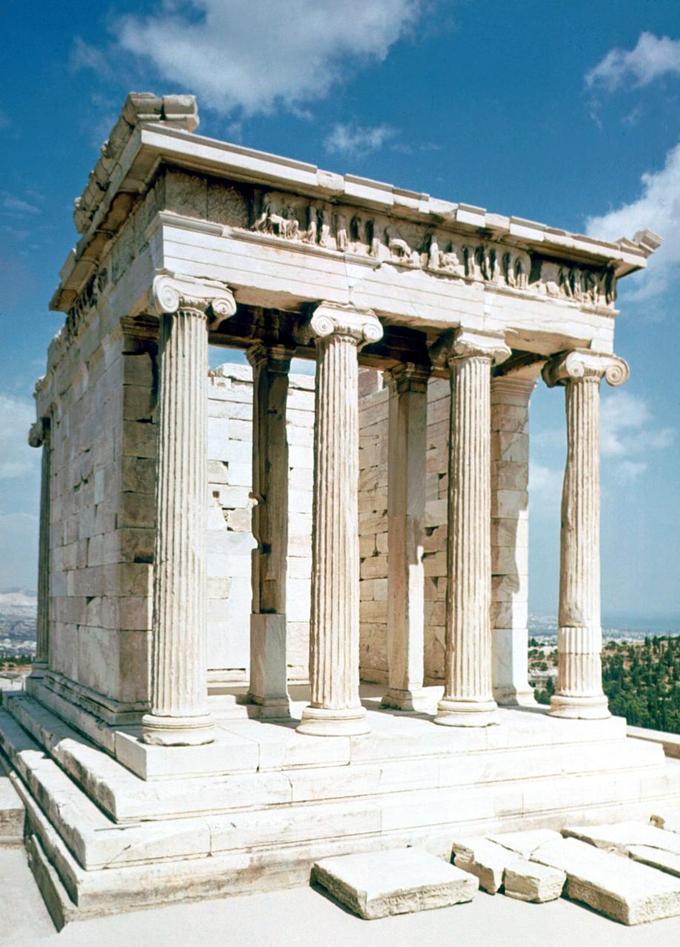
The continuous frieze around the temple depicts battle scenes from Greek history. These representations include battles from the Persian and Peloponnesian Wars, including a cavalry scene from the Battle at Marathon and the Greek victory over the Persians at the Battle of Plataea.
The scenes on the Temple of Athena Nike are similar to the battle scenes on the Parthenon, which represented Greek dominance over non-Greeks and foreigners in mythical allegory . The scenes depicted on the frieze of the Temple of Athena Nike frieze display Greek and Athenian dominance and military power throughout historical events.
A parapet was added on the balustrade to protect visitors from falling down the steep hillside. Images of Nike, such as Nike Adjusting Her Sandal, are carved in relief.

In this scene Nike is portrayed standing on one leg as she bends over a raised foot and knee to adjust her sandal. Her body is depicted in the new High Classical style. Unlike Archaic sculpture, this scene actually depicts Nike’s body. Her body and muscles are clearly distinguished underneath her transparent yet heavy clothing.
This style, known as wet drapery, allows sculptors to depict the body of a woman while still preserving the modesty of the female figure. Although Nike’s body is visible, she remains fully clothed. This style is found elsewhere on the Acropolis, such as on the caryatids and on the women in the Parthenon’s pediment.
The Parthenon, Athens: A Conversation
By Dr. Beth Harris and Dr. Steven Zucker
Learn about the great temple of Athena, patron of Athens, and the building’s troubled history. This is the transcript of a conversation conducted at the Acropolis in Athens. To watch the video: https://youtu.be/tWDflkBZC6U.
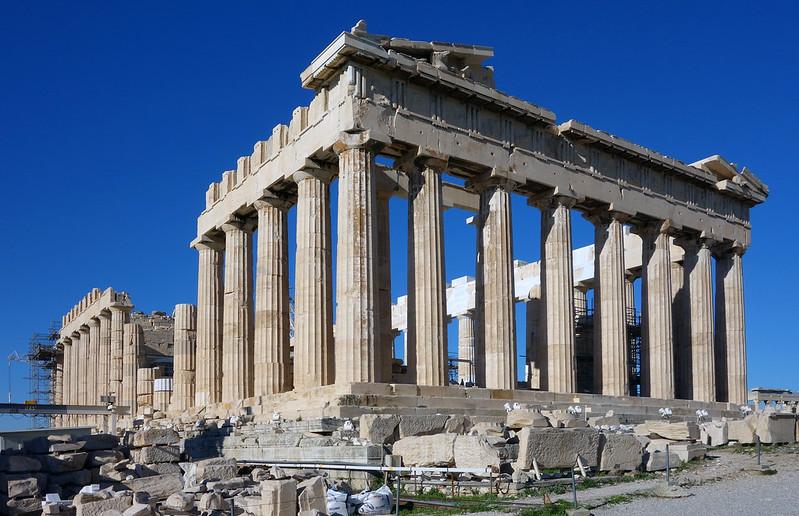
Steven: We’re looking at the Parthenon. This is a huge marble temple to the goddess Athena.
Beth: We’re on the top of a rocky outcropping in the city of Athens very high up overlooking the city, overlooking the Aegean Sea.
Steven: Athens was just one of many Greek city-states and almost everyone had an acropolis. That is, had a fortified hill within its city because these were warring states.
Beth: In the fifth century, Athens was the most powerful city-state and that’s the period that the Parthenon dates to.
Steven: This precinct became a sacred one rather than a defensive one. This building has had a tremendous influence not only because it becomes the symbol of the birth of democracy, but also because of its extraordinary architectural refinement. The period when this was built in the fifth century is considered the High Classical moment and for so much of Western history, we have measured our later achievements against this perfection.
Beth: It’s hard not to recognize so many buildings in the West. There’s certainly an association especially to buildings in Washington D.C. and that’s not a coincidence.
Steven: Because this is the birthplace of democracy—a limited democracy, but democracy nevertheless.
Beth: There was a series of reforms in the fifth century in Athens that allowed more and more people to participate in the government.
Steven: We think that the city of Athens had between 300,000 and 400,000 inhabitants, and only about 50,000 were actually considered citizens. If you were a woman, obviously, if you were a slave you were not participating in this democratic experiment.
Beth: This is a very limited idea of democracy.
Steven: This building is dedicated to Athena and, in fact, the city itself is named after her and of course there’s a myth. Two gods vying for the honor of being the patron of this city. Those two gods are Poseidon and Athena. Poseidon is the god of the sea and Athena has many aspects. She’s the goddess of wisdom, she is associated with war. A kind of intelligence about creating and making things. Both of these gods gave the people of this city a gift and then they had to choose. Poseidon strikes a rock and from it springs forth the saltwater of the sea. This had to do with the gift of naval superiority.
Beth: Athena offered, in contrast, an olive tree. The idea of the land of prosperity, of peace. The Athenians chose Athena’s gift. There actually is a site here on the acropolis where the Athenians believed you could see the mark of the trident from Poseidon where he struck the ground and also the tree that Athena offered.
Steven: Actually the modern Greeks have replanted an olive tree in that space. Let’s talk about the building. It is really what we think of when we think of a Greek temple but the style is specific. This is a Doric temple.
Beth: Although it has Ionic elements which we’ll get to.
Steven: The Doric features are really easy to identify. You have massive columns with shallow broad flutes, the vertical lines. Those columns go down directly into the floor of the temple which is called the stylobate and at the top, the capitals are very simple. There’s a little flare that rises up to a simple rectangular block called an abacus. Just above that are triglyphs and metopes.
Beth: It’s important to say that this building was covered with sculpture. There was sculpture in the metopes, there was sculpture in the pediments and in an unprecedented way a frieze that ran all the way around four sides of the building just inside this outer row of columns that we see. Now, this is an Ionic feature. Art historians talk about how this building combines Doric elements with Ionic elements.

Steven: In fact, there were four Ionic columns inside the west end of the temple.
Beth: When the citizens of Athens walked up the sacred way perhaps for religious procession or festival. They encountered the west end and they walked around it either on the north or south sides to the east and the entrance. Right above the entrance in the sculptures of the pediment, they could see the story of Athena and Poseidon vying to be the patron of the city of Athens. On the frieze just inside they saw themselves perhaps at least in one interpretation involved in the Panathenaic Procession, the religious procession in honor of the goddess Athena. This was a building that you walked up to, you walked around and inside was this gigantic sculpture of Athena.
Steven: These were all sculptures that we believe were overseen by the great sculptor Phidias and one of my favorite parts are the metopes. Carved with scenes that showed the Greeks battling various enemies either directly or metaphorically. The Greeks battling the Amazons, the Greeks against the Trojans, the Lapiths against the Centaurs, and the Gigantomachy. The Greek gods against the Titans.
Beth: All of these battles signified the ascendancy of Greece and of the Athenians of their triumphs. Civilization over barbarism, rational thought over chaos.
Steven: You’ve just hit on the very meaning of this building. This is not the first temple to Athena on this site. Just a little bit to the right as we look at the east end there was an older temple to Athena that was destroyed when the Persians invaded. This was a devastating blow to the Athenians.
Beth: One really can’t overstate the importance of the Persian War for the Athenian mindset that created the Parthenon. Athens was invaded and beyond that, the Persians sacked the Acropolis, sacked the sacred site, the temples. Destroyed the buildings.
Steven: They burned them down. In fact, the Athenians took a vow that they would never remove the ruins of the old temple to Athena.
Beth: So they would remember it forever.
Steven: But a generation later they did.
Beth: They did, well there was a piece that was established with the Persians and some historians think that that allowed them to renege that vow and Pericles, the leader of Athens embarked on this enormous, very expensive building campaign.
Steven: Historians believe that he was able to fund that because the Athenians had become the leaders of what is called the Delian League. An association of Greek city-states that paid a kind of tax to help protect Greece against Persia but Pericles dipped into that treasury and built this building.
Beth: This alliance of Greek city-states, their treasure, their tax money, their tribute was originally located in Delos hence the Delian League, but Pericles managed to have that treasure moved here to Athens and actually housed in the Acropolis. The sculpture of Athena herself which was made of gold and ivory Phidias said if we need money we can melt down the enormous amount of gold that decorates this sculpture of Athena.
Steven: Since that sculpture doesn’t exist any longer we know somebody did that. We need to imagine this building not pristine and white but rather brightly colored and also a building that was used. This was a storehouse. It was the treasury and so we have to imagine that it was absolutely full of valuable stuff.
Beth: In fact, we have records that give us some idea of what was stored here. We think about temples or churches or mosques as places where you go in to worship. That’s not how Greek religion work. There usually was an altar on the outside where sacrifices were made and the temple was the house of the god or goddess, but with the Parthenon art historians and archeologists have not been able to locate an altar outside so we’ve wondered what was this building? One answer is it was a treasury.
Steven: It also functions symbolically. It is up on this hill. It commands this extraordinary view from all parts of the city, and so it was a symbol of both the city’s wealth and power.
Beth: It’s a gift to Athena. When you make a gift to your patron goddess you want visitors to be awed by the image of the goddess that was inside and of her home.
Steven: This isn’t any goddess. This is the goddess of wisdom so the ability of man to understand our world and its rules mathematically, and then to express them in a structure like this is absolutely appropriate.
Beth: Iktinos is a supreme mathematician. I mean we know that the Greeks even in the archaic period before this were concerned with ideal proportions.
Steven: Pythagoras.

Beth: Or the sculptor Polykleitos and his sculpture of the Doryphoros searching for perfect proportions and harmony and using mathematics as the basis for thinking that through.
Steven: We have that here.
Beth: To an unbelievable degree.
Steven: What’s extraordinary is that its perfection is an illusion based on a series of subtle distortions that actually correct for the imperfections of our sight. That is, the Greeks recognize that human perception was itself yawed and that they needed to adjust for it in order to give the visual impression of perfection. Their mathematics and their building skills were precise enough to be able to pull this off.
Beth: Every stone was cut to fit precisely.
Steven: When we look at this building we assume it’s rectilinear, it’s full of right angles, and in fact, there’s hardly a right angle in this building.
Beth: There’s another interpretation of these tiny deviations that these deviations give the building a sense of dynamism. The sense of the organic that otherwise, it would seem static and lifeless. The Greeks had used this idea that art historians call entasis before in other buildings- slight adjustments. For example, columns bulge toward the center. This is not new but the degree to which it’s used here and the subtlety in the way it’s used is unprecedented.
Steven: For instance, in those Doric columns you can see that there’s a taper and you assume that it’s a straight line but the Greeks wanted ever so slight a sense of the organic. That the weight of the building was being expressed in the bulge, the entasis of the column about a third of the way from the bosom. In this case, every single column bulges only 11/16th of an inch the entire length of that column. The way that the Greeks pulled this off is they would bring column drums up to the site. They would carefully carve the base and the top and then they would carve in between.
Beth: We see this slight deviation in the columns but we also see it not only vertically but also horizontally in the building.

Steven: That’s right. You assume that the stylobate, the floor of the temple, is flat but it’s not. Rainwater would run off it because the edges are lower than the center.
Beth: But only very, very slightly lower.
Steven: Across the long side of the temple the center rises only 4 3/8 of an inch and on the short side of the temple on the east and the west side the center rises only by 2 3/8 inches. What happens is it cracks. Our eye would naturally see a straight line seem as if it rises up at the corners a little bit so it seems to us to be perfectly flat. The columns are all leaning in a little bit.
Beth: You would expect the columns to be equidistant from one another but in fact, the columns on the edges are slightly closer to one another than the columns in the center of each side.
Steven: Architectural historians have hypothesized that the reason for this is because the column at the edge is in the sense an orphan. It doesn’t have anything past it. Therefore, it would seem to be less substantial. If we could make that column a little bit closer to the one next to it it might compensate and it would have an even sense of density across the building.
Beth: Placing of the columns closer together on the edges create a problem in the levels above. One of the rules of the Doric Order is that there had to be a triglyph right above the center of a column or in between each column.
Steven: They also wanted the triglyphs to be at the very edge so one triglyph would abut against another triglyph at the corner of the building. If in fact, you’re placing your columns closer together you can actually solve for that problem, you can avoid the stretch of the metope in between those triglyphs that would result, but because the columns are placed so close together they had the opposite problem which is to say that the metopes at the ends of the building would be too slender. What Phidias has done in concert with Iktinos and Kallikrates the architects is to create sculptural metopes that are widest in the center just like the spaces between the columns and actually the metopes themselves gradually become thinner as you move to the edges so that you can’t really even perceive the change without measuring.
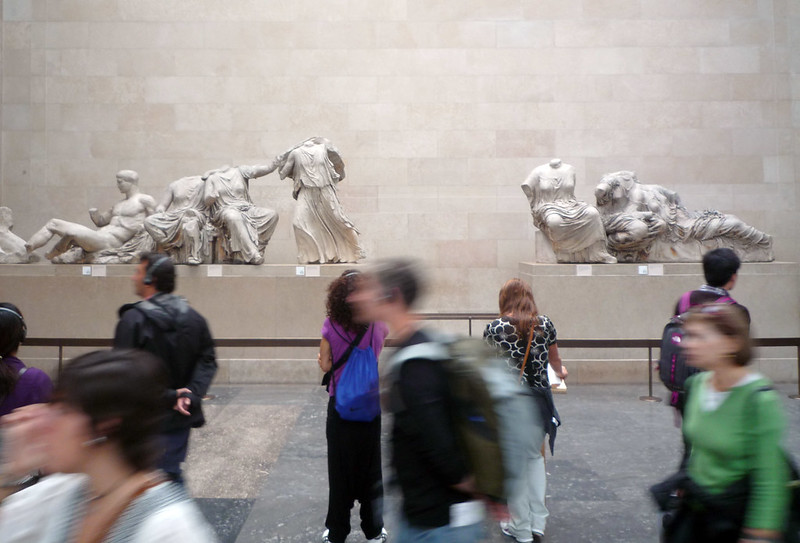
Beth: The general proportions of the building can be expressed mathematically as X = Y x 2 + 1. Across the front, we see eight columns and along the sides 17 columns. That ratio also governs the spacing between the columns and its relationship to the diameter of a column. Math is everywhere.
Steven: If we look at the plan of the structure we see the exterior colonnade on all four sides. On the east and west end, it’s actually a double colonnade and on the long sides, inside the columns a solid a solid masonry wall. You can enter rooms on the east-west only. The west has a smaller room with the four Ionic columns within it but the east room was larger and held the monumental sculpture of Athena. It’s interesting. The system that was used to create a vault that was high enough to enclose a sculpture that was almost 40 feet high was unique. There was a U shape of interior columns at two storeys. They were Doric and they surrounded the goddess. The sculpture is now lost but the building is almost lost as well. Here we come to one of the great tragedies of western architecture. This building survived into the seventeenth century and was in pretty good shape for 2000 years and it’s only in the modern era that it became a ruin.
Beth: First it was as we know an ancient Greek temple for Athena then it became a Greek Orthodox church then a Roman catholic church and then a mosque In a war between the Ottomans who were in control of Greece at this moment in history in the seventeenth century and the Venetians. The Venetians attacked the Parthenon, the Ottomans used the Parthenon to hold ammunition, gunpowder. Gunpowder exploded from the inside, basically ripping the guts out of the Parthenon.
Steven: Then to add insult to injury in the eighteenth century, Lord Elgin received permission from the Turkish government to take sculptures that had already fallen ow the temple and bring them back to England. The lion’s share of the great sculptures by Phidias are now in London. Greece recently has built a museum just down the hill from the Acropolis specifically intended to house these sculptures should the British ever release them.
Beth: Some have argued that Elgin saved the sculptures that would have been further damaged had he not removed them, but what to do about the future is uncertain.
Steven: At least one theory states that this building was paid for by plundered treasury from the Delian League so there’s a long history of contested ownership.

Beth: As we stand here very high up on the Acropolis overlooking the Aegean Sea, islands beyond and mountains on this glorious day, I can’t help but imagine standing inside the Parthenon between those columns, which we can’t do today.
Steven: The site is undergoing tremendous restoration. There are cranes, the scaffolding to maintain the ruin and not let it fall into worst disrepair.
Beth: But if we could stand there what would it feel like?
Steven: There is this beautiful balance between the theoretical and the physical. The Greeks thought about mathematics as the way that we could understand the divine and here it is in our world.
Beth: There’s something about the Parthenon that is both an offering to Athena, the protector of Athens, but also something that’s a monument to human beings, to the Athenians, to their brilliance, and by extension, I suppose, in the modern era, human spirit generally.
Painting in the Greek High Classical Period
The Classical Era was a 200-year period in Greek culture that lasted from the fifth through fourth centuries BCE. This Classical period, following the Archaic period and succeeded by the Hellenistic period, had a powerful influence on the Roman Empire and greatly influenced the foundations of the Western Civilization. Much of modern Western politics and artistic thought, such as architecture, scientific thought, literature, and philosophy, derives from this period of Greek history.
Panel Painting
Panel painting is the painting on flat panels of wood, either a single large piece or several joined together. Because of their organic nature many panel paintings no longer exist. Panel paintings were usually done in encaustic or tempera and were displayed in the interior of public buildings, such as in the pinacoteca of the Propylaea of the Athenian Acropolis.
The earliest known panel paintings are the Pitsa Panels that date to the Archaic period between 540 and 530 BCE; however, panel painting continued throughout the Classical Period.
The painter Apollodorus was considered by the Greeks and Romans to be one of the best painters of the Early Classical period, although none of his work survived. He is credited for the use of creating shadows by a technique known as skiagraphia. The technique layers crosshatching and contour liners to add perspective to the scene and is similar to the Renaissance technique of chiaroscuro.

Tomb Painting
Tomb painting was another popular method of painting, which due to its fragile nature has often not survived. However, a few examples do remain, including the 480 BCE Tomb of the Diver and the wall paintings from the royal Macedonian tombs in Vergina that date to the mid-fourth century BCE. A comparison between the paintings demonstrate how painting followed sculptural development in regards to the rendering of the human body.
The Tomb of the Diver is from a small necropolis in Paestum, Italy, which was then the Greek colony of Poseidonia, and dates from the beginning of the Classical period. The tomb depicts a symposium scene on its walls and an image of diver on the inside of the covering slab.
The images are painted in true fresco with a limestone mortar. The scene of the diver is simple image with a small landscape of trees, water, and the diver’s platform. The diver is nude and his body is simply defined through the use of line and color. The bodies of the men at the symposium more accurately demonstrate an Archaic reliance on line to model the form of the body and the draping of their clothing.
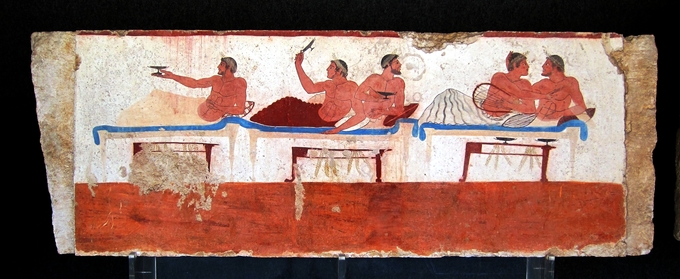
Compared to the wall paintings from the tombs at Vergina, the Early Classical tomb painting is static and rather Archaic. The frescos from Vergina depict figures in a full-painted version of the High Classical style .
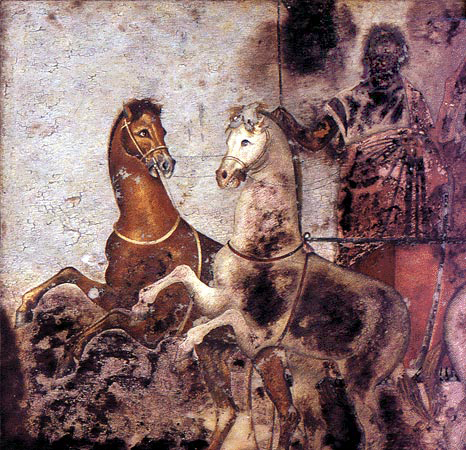
For example, there is an image believed to depict King Philip II on a chariot pulled by two horses. The fresco is poorly preserved but one is able to see on Philip’s horse the modeling of the animals produced by the color shading and a suggestion of perspective when looking at the chariot. The artist relies on the shades and hues of his paints to create depth and a life-like feeling in the painting.
One of the quintessential wall paintings at Vergina is Hades Abducting Persephone. The painted scene appears similar to the Late Classical sculptural style and the dynamic, emotion-filled composition seems to predict the style of Hellenistic sculpture.
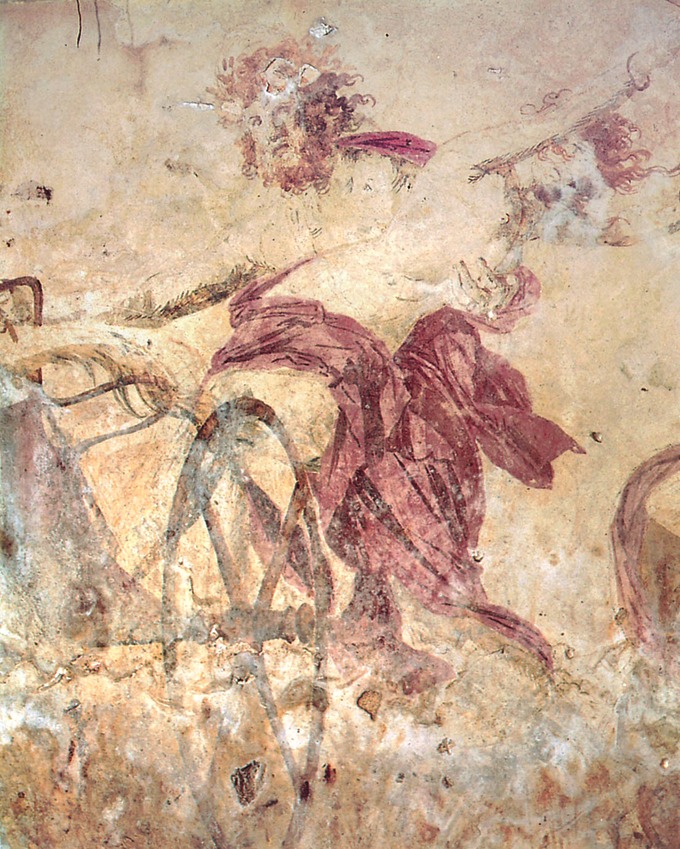
The scene depicts Hades on his chariot, grasping on to Persephone’s nude torso as the pair ride away. The colors are faded and faint, but the bright red drapery worn by Persephone is still easily identifiable. Lines and shading emphasize its folds.
The style appears almost impressionistic, especially when examining Persephone’s face and hair. Persephone and Hades create a tension filled chiastic composition, as Hades races to the left, against the pull of Persephone’s outward, desperate reach to the right.
Alexander the Great
Alexander III of Macedonia (356–323 BCE), better known as Alexander the Great, very carefully controlled and crafted his portraiture. In order to maintain control and stability in his empire, he had to ensure that his people recognized him and his authority.
Because of this, Alexander’s portrait was set when he was very young, most likely in his teens, and it never varied throughout his life. To further control his portrait types, Alexander hired artists in different media such as painting, sculpture, and gem cutting to design and promote the portrait style of the medium. In this way, Alexander used art and artisans for their propagandistic value to support and provide a face and legitimacy to his rule.
Alexander Mosaic
The Alexander Mosaic is a Roman floor mosaic from approximately 100 BCE that was excavated from the House of the Faun in Pompeii. The mosaic depicts the Battle of Issus that occurred between the troops of Alexander the Great and King Darius III of Persia. The mosaic is believed to be a copy of a large-scale panel painting by Aristides of Thebes, or a fresco by the Philoxenos of Eretria from the late fourth century BCE.
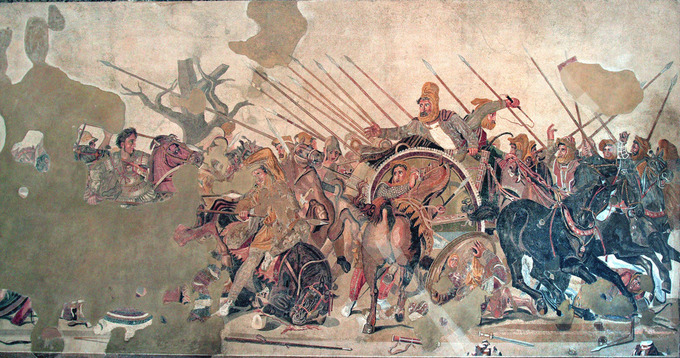
The mosaic is remarkable. It depicts a keen sense of detail, dramatically unfolds the drama of the battle, and demonstrates the use of perspective and foreshortening . The two main characters of the battle are easily distinguishable and this portrait of Alexander may be one of his most recognizable. He wears a breastplate and an aegis , and his hair is characteristically tousled. He rides into battle on his horse, Bucephalo, leading his troops. Alexander’s gaze remains focused on Darius and he appears calm and in control, despite the hectic battle happening around him.
Darius III, on the other hand, commands the battle in desperation from his chariot, as his charioteer removes them from battle. His horses flee under the whip of the charioteer and Darius leans outward, stretching out a hand having just thrown a spear. His body position contradicts the motion of his chariot, creating tension between himself and his flight.
Other details in the mosaic include the expressions of the soldiers and the horses, such as a collapsed horse and his rider in the center of the battle, to a terrified fallen Persian, whose expression is reflected on his shield.
The shading and play of light in the mosaic, reflects the use of light and shadow in the original painting to create a realistic, three-dimensional space . Horses and soldiers are shown in multiple perspectives from profile, to three quarter, to frontal, and one horse even faces the audience with his rump. The careful shading within the mosaic tesserae models the characters to give the figures mass and volume.

The Farnese Hercules: A Conversation
By Dr. Beth Harris and Dr. Steven Zucker
Weary from his labors, Hercules leans on his club, with hints of his heroic trials hidden in plain sight. This is the transcript of a conversation conducted at the Naples Archaeological Museum. To watch the video: https://youtu.be/T-Yv4mp5yp8.
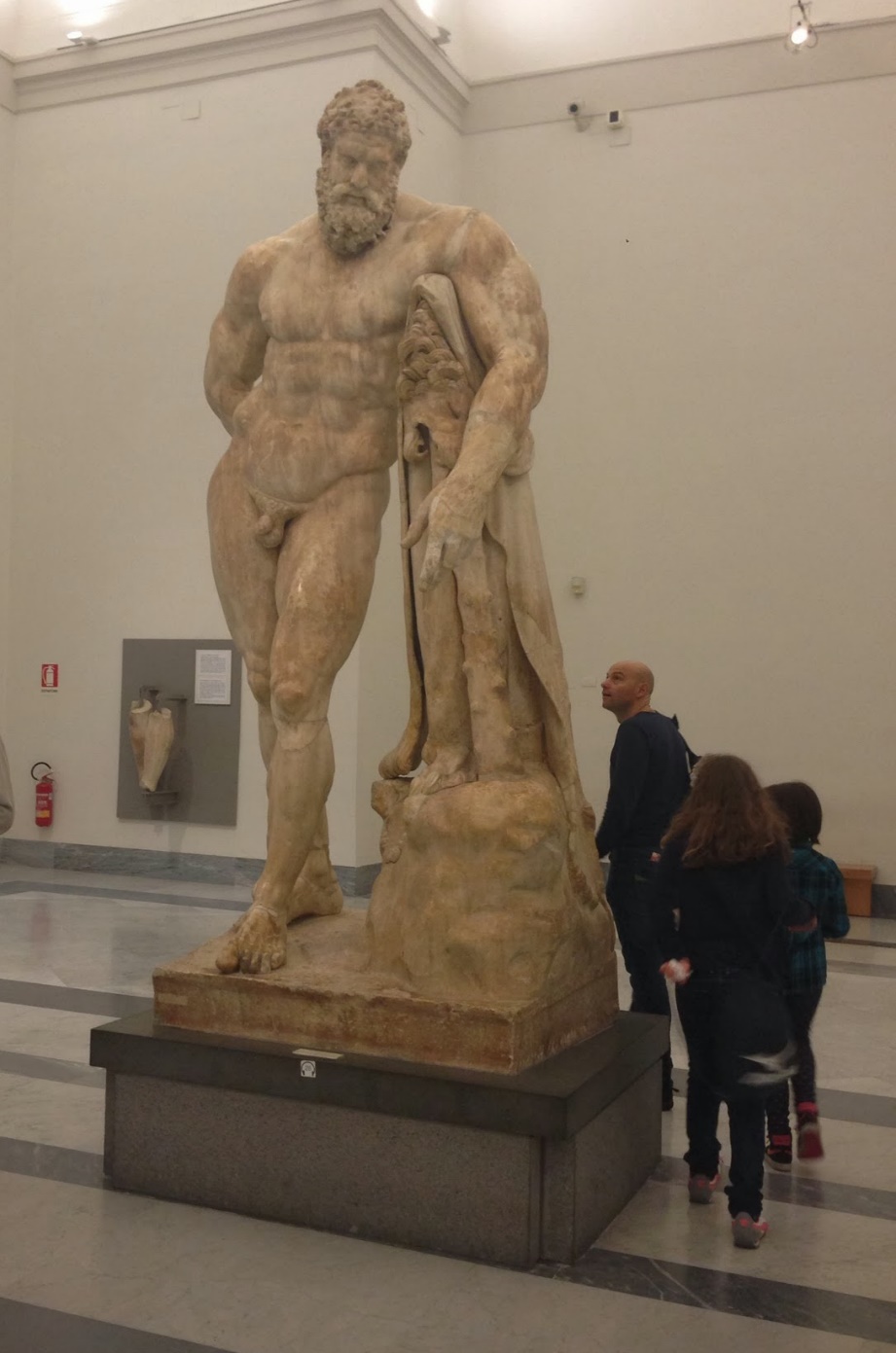
Dr. Zucker: We’re in Naples at the Archaeological Museum, looking at one of the most famous sculptures from all of antiquity.
Dr. Harris: It was discovered in the Renaissance during archaeological excavations in Rome of the Baths of Caracalla.
Dr. Zucker: This is the so-called Farnese Hercules and it gets that name because it was excavated by the Farnese family. They had been looking for building materials to take from ancient sites to build a new palace, but what they found in the Baths were an extraordinary array of ancient sculptures.
Dr. Harris: We can reconstruct the original site for this colossal sculpture. There were mosaic floors, walls made of different colored marble. It was an incredibly luxurious bathing complex, used by thousands of Romans every day and it was decorated with hundreds of sculptures, many of them colossal, like this one.
Dr. Zucker: These were really complex structures, these bathing facilities. There were the baths themselves. Some were cold, some were hot. There were rooms for transition from one temperature to another. There were places where one could exercise and this sculpture makes perfect sense in this environment. This is a place where you would go to work out, where you would go to exercise. You could look at this wildly muscular figure and have a bit of a goal.
Dr. Harris: Many of the sculptures that were found in the Baths of Caracalla were not the typical, ideal, athletic copies of Greek sculptures that we think of, but they were especially bulky, like the Hercules that we see here.
Dr. Zucker: We know that some successful Greek athletes would sometimes dedicate sculptures to Hercules in a way thanking him for their successes.
Dr. Harris: He was a symbol of strength and heroism.
Dr. Zucker: You can see that here, but there’s also irony in Lysippos’ treatment, because even as we see this wildly powerful figure, this incredible musculature, we also see a figure that is exhausted.
Dr. Harris: He really is. He leans almost his full weight on a club that’s propped up under his arm, so you’re right, there is an irony between the brute strength of his articulated muscles and the languorousness of his pose.
Dr. Zucker: Look at the way in which that abdomen is articulated. Look at the strength of his right shoulder, of his right upper arm. It’s really massive.
Dr. Harris: He thrusts his right hip out, so that he can fully lean his weight on his left side.
Dr. Zucker: There is this marvelous contrapposto, although the legs seem to be somewhat reversed, but I love the way his torso slouches over as he leans and there’s this overemphasized turn of that torso.
Dr. Harris: But the club doesn’t look like a very secure support.
Dr. Zucker: No, the whole thing is slightly precarious.
Dr. Harris: It seems as if Lysippos and Glycon, who copied Lysippos’ sculpture and there are more than 80 copies of sculptures of the weary Hercules that have survived, but it does seem as though he’s calling our attention to Hercules’ hands and Hercules is famous as a hero who became a god and who these amazing exploits, the 12 labors of Hercules. I’m noticing the open left hand and the way that the right hand is brought behind his back, so we really want to move around the sculpture to see what’s in his right hand.
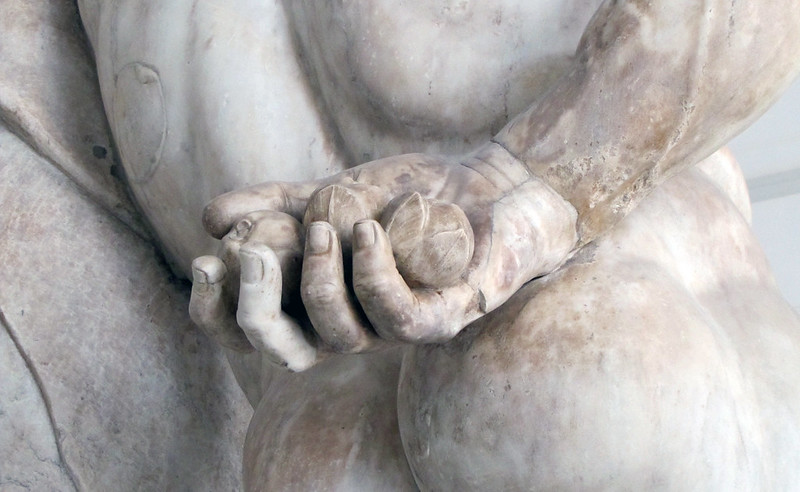
Dr. Zucker: That’s right. The artist has set us up so that we absolutely want to walk around. The left hand is not original, that’s been lost. So what we’re seeing is a plaster reconstruction, but the right hand is original and if you walk around the sculpture, you actually see that he’s holding the apples that he would have gotten from one of those labors, the labor the apples of the Hesperides. This is all part of the legend of Heracles. Heracles was the original Greek figure and the Romans would call him Hercules. What happened was this brute of a man, in a fit, killed his children. The gods of Mount Olympus punished him by putting this man, Heracles, who was the son of a god and of a human, therefore a hero. They made him subservient to a king and he had to perform whatever deeds this king asked of him for 12 years. This was his punishment. The king asked of him tremendously difficult tasks. The first of which was the killing of the Nemean lion. If you look carefully, just draped over the club, you can see the pelt of that lion that he had slayed. This sculpture is actually referring to two of those labors.
Dr. Harris: One of the things that seems a little strange as we look up at him is how small his head is. This is something that Lysippos, the Greek sculptor–
Dr. Zucker: The original sculptor–
Dr. Harris: That this was based on, was known for, was changing the cannon of proportions that existed during the Classical period in Greece in the fifth century where there was more of a sense of harmony and balance between the parts of the body. Lysippos created a new set of proportions, where the figure was taller, the head was smaller, and they gave the figure a new sense of elegance.
Dr. Zucker: Elegance and also height. Here, it’s married, of course, with this increased bulk. The other thing that Lysippos is so well known for, which you mentioned earlier, is the way in which he begins to break out of the more restricted space that Classical figures had generally occupied, so that by extending, for instance, that left hand, by moving that right hand behind his back, he really does invite us to understand this sculpture in the round, as opposed to seeing it as a frontal object. The thing that strikes me most, though, about this sculpture, is the way in which we can understand his feeling of exhaustion and the way that’s contrasted against the potential energy and power of that body.
Dr. Harris: The things that we’re talking about, the new cannon of proportions, the way that we’re asked to move around the sculpture, not only do I want to walk behind it to see what’s in his right hand, but I also want to walk to the place where he is looking down to, so we can look up at his face and see the expression, the sense of empathy we have for him. These are all things that are typical of the Hellenistic period of ancient Greek art that this copy was based on.
Dr. Zucker: Clearly, something that the Romans really appreciated.
Hellenistic Sculpture
Altar of Zeus

The great Altar of Zeus (now housed in Germany) was commissioned in the first half of the second century BCE during the reign of King Eumenes II to commemorate his victory over the Gauls, who were migrating into Asia Minor.

The altar is a U-shaped Ionic building built on a high platform with central steps leading to the top. It faced east, was located near the theater of Pergamon, and commanded an outstanding view of the region. The altar is known for its grand design and for its frieze depicting the Gigantomachy—it wraps 370 feet around the base of the altar.
The Gigantomachy
The Gigantomachy depicts the Olympian gods fighting against their predecessors the Giants (Titans), the children of the goddess Gaia. The frieze is known for its incredibly high relief, in which the figures are barely restrained by the wall, and for its deep drilling of lines with details to create dramatic shadows.
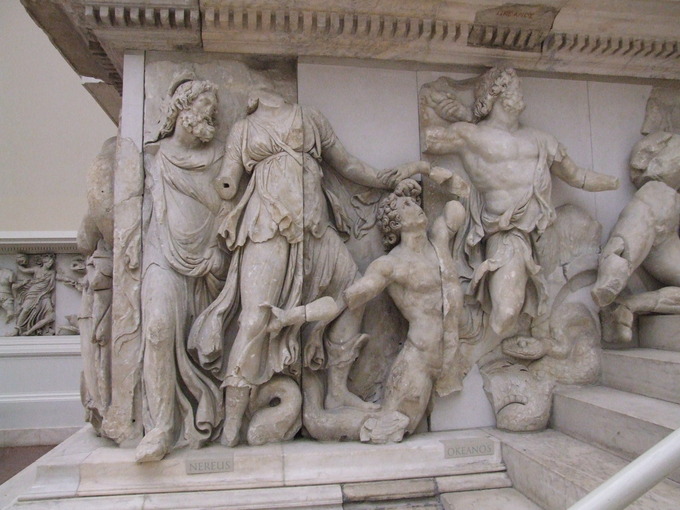
The high relief and deep drilling of the figures also increases the liveliness and naturalism of the scene. The figures are rendered with high plasticity. The texture of their skin, drapery, and scales add another level of naturalism. Furthermore, as the frieze follows the stairs, the limbs of the figures begin to spill out of their frame and onto the stairs, physically breaking into the space of the viewer . The style and high drama of the scenes is often referred to as the Hellenistic Baroque for its exaggerated motion, emphasis on details, and the liveliness of the characters.
The most famous scene on the frieze depicts Athena fighting the giant Alkyoneus. She grabs his head and pulls it back while Gaia emerges from the ground to plead for her son’s life and a winged Nike reaches over to crown Athena.
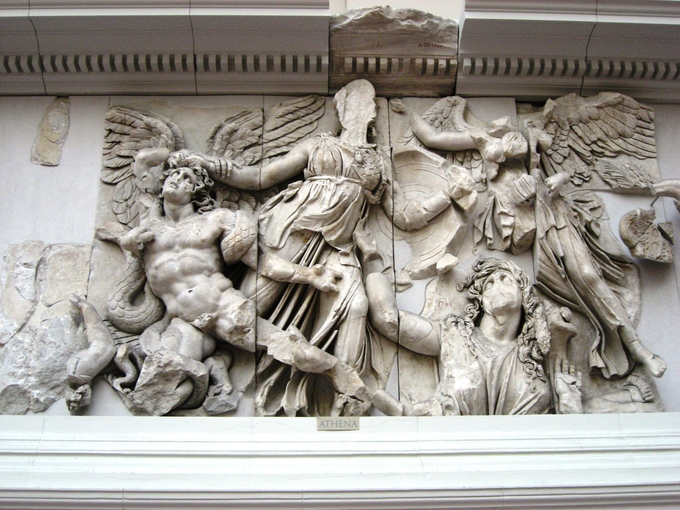
Athena’s drapery swirls around her with deep folds and her whole body is nearly removed from the frieze. The figures are depicted with the heightened emotion commonly found on Hellenistic statues. Alkyoneus’s face strains in pain and Gaia’s eyes, which are all that remain of her face, are full of terror and sorrow at the death of her son.
The entire composition is depicted in a chiastic shape. Athena stretches out to grasps Alkoyneus’s head, the two figures pull at each other in opposite directions. Meanwhile, the figure of Nike moves diagonally towards Athena, showing their convergence in a moment of victory. The diagonal line created by Gaia mimics the shape of her son, connecting the two figures through line and pathos. The scene is filled with the tension and emotion that are key features in Hellenistic sculpture.
The Dying Gauls
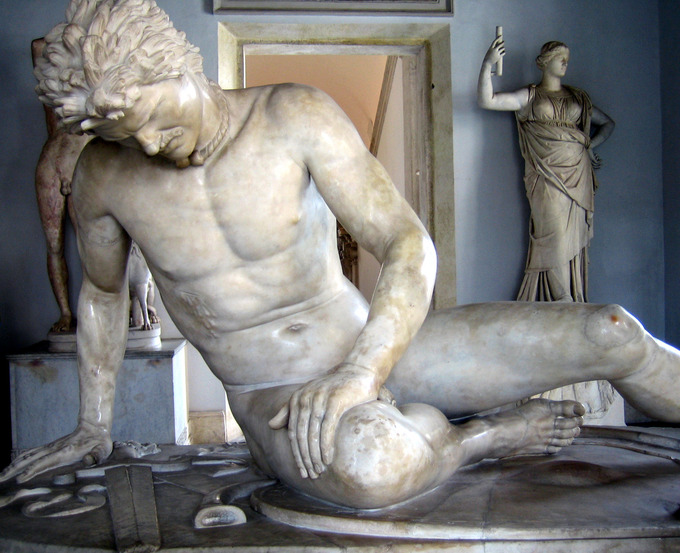
A group of statues depicting dying Gauls, the defeated enemies of the Attalids, were situated inside the Altar of Zeus. The original set of statues is believed to have been cast in bronze by the court sculptor Epigonus in 230–220 BCE. Now only marble Roman copies of the figures remain.
Like the figures on the frieze and other Hellenistic sculptures, the figures are depicted with lifelike details and a high level of naturalism. They are also depicted in the common motif of barbarians. The men are nude and wear Celtic torcs [necklaces indicating status]. Their hair is shaggy and disheveled. The figures are positioned in dramatic compositions and are shown dying heroically, which turns them into worthy adversaries, increasing the perception of power of the Attalid dynasty. All three figures in the group are depicted in a Hellenistic manner. To fully appreciate the statues, it is best to walk around them. Their pain, nobility, and death are evident from all angles.
One Gaul is depicted lying down, supporting himself over his shield and a discarded trumpet. He furrows his brow as he looks downward at his bleeding chest wound as he prepares himself for death. His muscles are large and strong, signifying his strength as a warrior and implying the strength of the one who struck him down.

Two other figures complete the group. One figure depicts a Gallic chief committing suicide after he has killed his own wife. Also known as the Ludovisi Gaul, this sculpture group displays another heroic and noble deed of the foes, for typically women and children of the defeated would be murdered to avoid them from being captured and sold as slaves by the victors. The chief holds his fallen wife by the arm
as he plunges his sword into his chest, where blood is already exiting the wound.
Hellenistic sculpture continues the trend of increasing naturalism seen in the stylistic development of Greek art. During this time, the rules of Classical art were pushed and abandoned in favor of new themes, genres , drama, and pathos that were never explored by previous Greek artists.
Furthermore, the Greek artists added a new level of naturalism to their figures by adding an elasticity to their form and expressions, both facial and physical. These figures interact with their audience in a new theatrical manner by eliciting an emotional reaction from their view—this is known as pathos.
Nike of Samothrace
One of the most iconic statues of the period, the Nike of Samothrace, also known as the Winged Victory (c. 190 BCE), commemorates a naval victory. This Parian marble statue depicts Nike, now armless and headless, alighting onto the prow of the ship. The prow is visible beneath her feet, and the scene is filled with theatricality and naturalism as the statue reacts to her surroundings.
Nike’s feet, legs, and body thrust forward in contradiction to her drapery and wings that stream backwards. Her clothing whips around her from the wind and her wings lift upwards. This depiction provides the impression that she has just landed and that this is the precise moment that she is settling onto the ship’s prow.
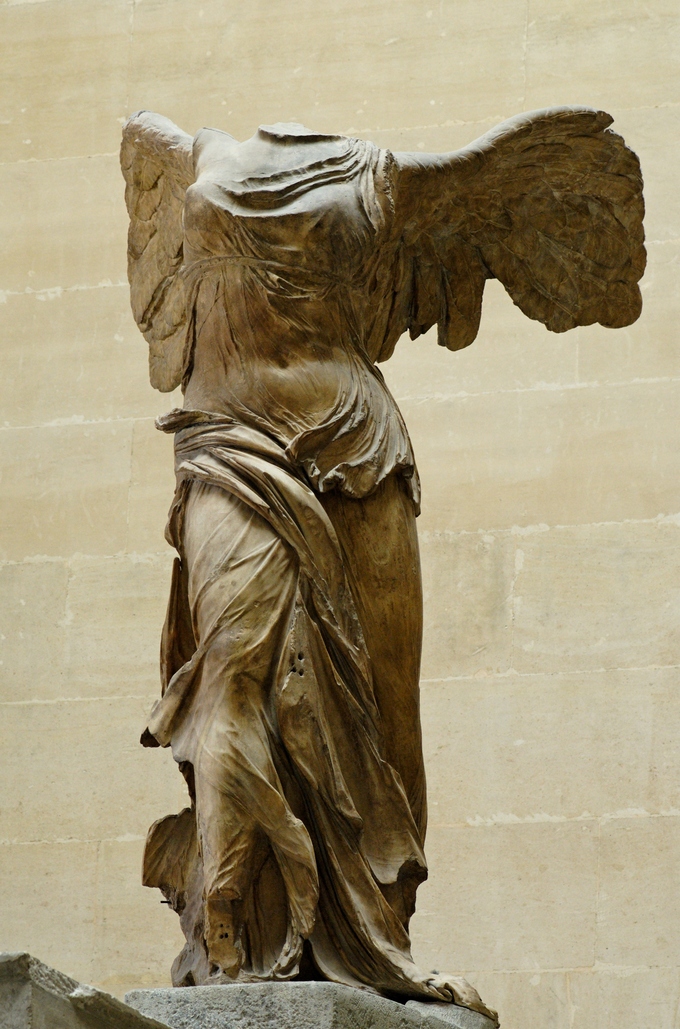
In addition to the sculpting, the figure was most likely set within a fountain, creating a theatrical setting where both the imagery and the auditory effect of the fountain would create a striking image of action and triumph.
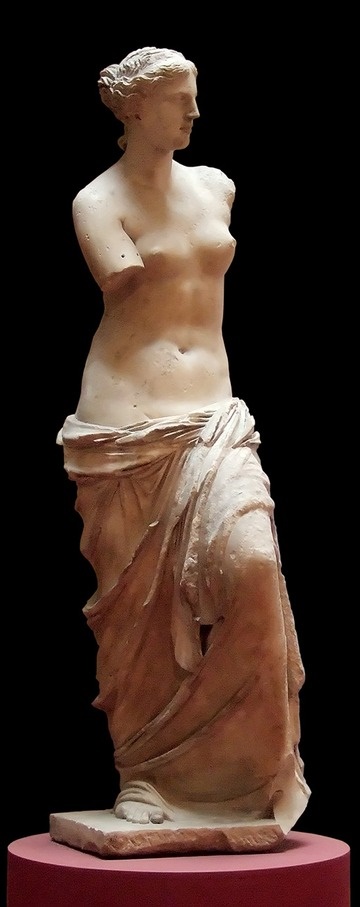
Venus de Milo
Also known as the Aphrodite of Melos (c. 130–100 BCE), this sculpture by Alexandros of Antioch, is another well-known icon of the Hellenistic period. Today the goddess’s arms are missing. It has been suggested that one arm clutched at her slipping drapery while the other arm held out an apple, an allusion to the Judgment of Paris and the abduction of Helen.
Originally, like all Greek sculptures, the statue would have been painted and adorned with metal jewelry, which is evident from the attachment holes. This image is in some ways similar to Praxiteles’ Late Classical sculpture Aphrodite of Knidos (fourth century BCE), but it is considered to be more erotic than its earlier counterpart.
For instance, while she is covered below the waist, Aphrodite makes little attempt to cover herself. She appears to be teasing and ignoring her viewer, instead of accosting him and making eye contact.
Altered States
While the Nike of Samothrace exudes a sense of drama and the Venus de Milo a new level of feminine sexuality, other Greek sculptors explored new states of being. Instead of reproducing images of the ideal Greek male or female, as was favored during the Classical period, sculptors began to depict images of the old, tired, sleeping, and drunk—none of which are ideal representations of a man or woman.
The Barberini Faun

The Barberini Faun, also known as the Sleeping Satyr (c. 220 BCE), depicts an effeminate figure, most likely a satyr, drunk and passed out on a rock. His body splays across the rock face without regard to modesty.
He appears to have fallen to sleep in the midst of a drunken revelry and he sleeps restlessly, his brow is knotted, face worried, and his limbs are tense and stiff. Unlike earlier depicts of nude men, but in a similar manner to the Venus de Milo, the Barberini Faun seems to exude sexuality.

Drunken Old Woman
Images of drunkenness were also created of women, which can be seen in a statue attributed to the Hellenistic artist Myron of a drunken beggar woman. This woman sits on the floor with her arms and legs wrapped around a large jug and a hand gripping the jug’s neck.
Grape vines decorating the top of the jug make it clear that it holds wine. The woman’s face, instead of being expressionless, is turned upward and she appears to be calling out, possibly to passersby. Not only is she intoxicated, but she is old: deep wrinkles line her face, her eyes are sunken, and her bones stick out through her skin.
Seated Boxer

Another image of the old and weary is a bronze statue of a seated boxer. While the image of an athlete is a common theme in Greek art, this bronze presents a Hellenistic twist.
He is old and tired, much like the Late Classical image of a Weary Herakles. However, unlike Herakles, the boxer is depicted beaten and exhausted from his pursuit. His face is swollen, lip spilt, and ears cauliflowered. This is not an image of a heroic, young athlete but rather an old, defeated man many years past his prime.

Portraiture
Individual portraits, instead of idealization, also became popular during the Hellenistic period. A portrait of Demosthenes by Polyeuktos (280 BCE) is not an idealization of the Athenian statesman and orator. Instead, the statue takes notes of Demosthenes’s characteristic features, including his overbite, furrowed brow, stooped shoulders, and old, loose skin.
Even portrait busts, often copied from Polyeuktos’ famed statue, depict the weariness and sorrow of a man despairing the conquest of Philip II and end of Athenian democracy.
Roman Patronage
The Greek peninsula fell to Roman power in 146 BCE. Greece was a key province of the Roman Empire, and the Roman’s interest in Greek culture helped to circulate Greek art around the empire, especially in Italy, during the Hellenistic period and into the Imperial period of Roman hegemony .
Greek sculptors were in high demand throughout the remaining territories of the Alexander’s empire and then throughout the Roman Empire. Famous Greek statues were copied and replicated for wealthy Roman patricians and Greek artists were commissioned for large-scale sculptures in the Hellenistic style.
Originally cast in bronze, many Greek sculptures that we have today survive only as marble Roman copies. Some of the most famous colossal marble groups were sculpted in the Hellenistic style for wealthy Roman patrons and for the imperial court. Despite their Roman audience, these were purposely created in the Greek style and continued to display the drama, tension, and pathos of Hellenistic art.
Laocoön and His Sons
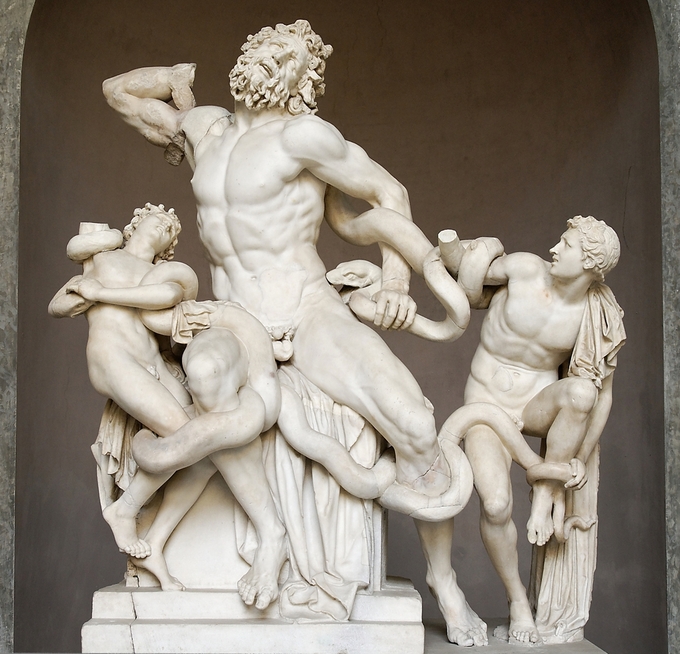
Laocoön was a Trojan priest of Poseidon who warned the Trojans, “Beware of Greeks bearing gifts,” when the Greeks left a large wooden horse at the gates of Troy. Athena or Poseidon (depending on the story’s version), upset by his vain warning to his people, sent two sea serpents to torture and kill the priest and his two sons.
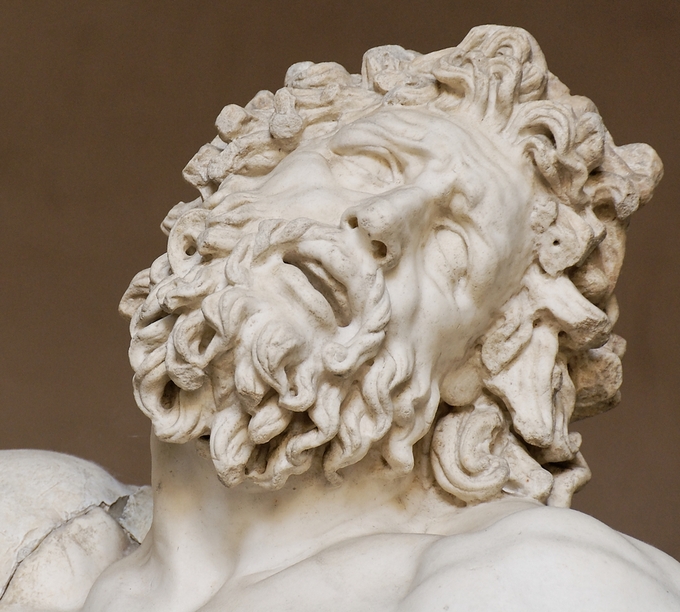
Similar to other examples of Hellenistic sculpture, Laocoön and His Sons depicts a chiastic scene filled with drama, tension, and pathos. The figures writhe as they are caught in the coils of the serpents. The faces of the three men are filled with agony and toil, which is reflected in the tension and strain of their muscles. Laocoön stretches out in a long diagonal from his right arm to his left as he attempts to free himself.His sons are also entangled by the serpents, and their faces react to their doom with confusion and despair. The carving and detail, the attention to the musculature of the body, and the deep drilling, seen in Laocoön’s hair and beard, are all characteristic elements of the Hellenistic style.
Farnese Bull
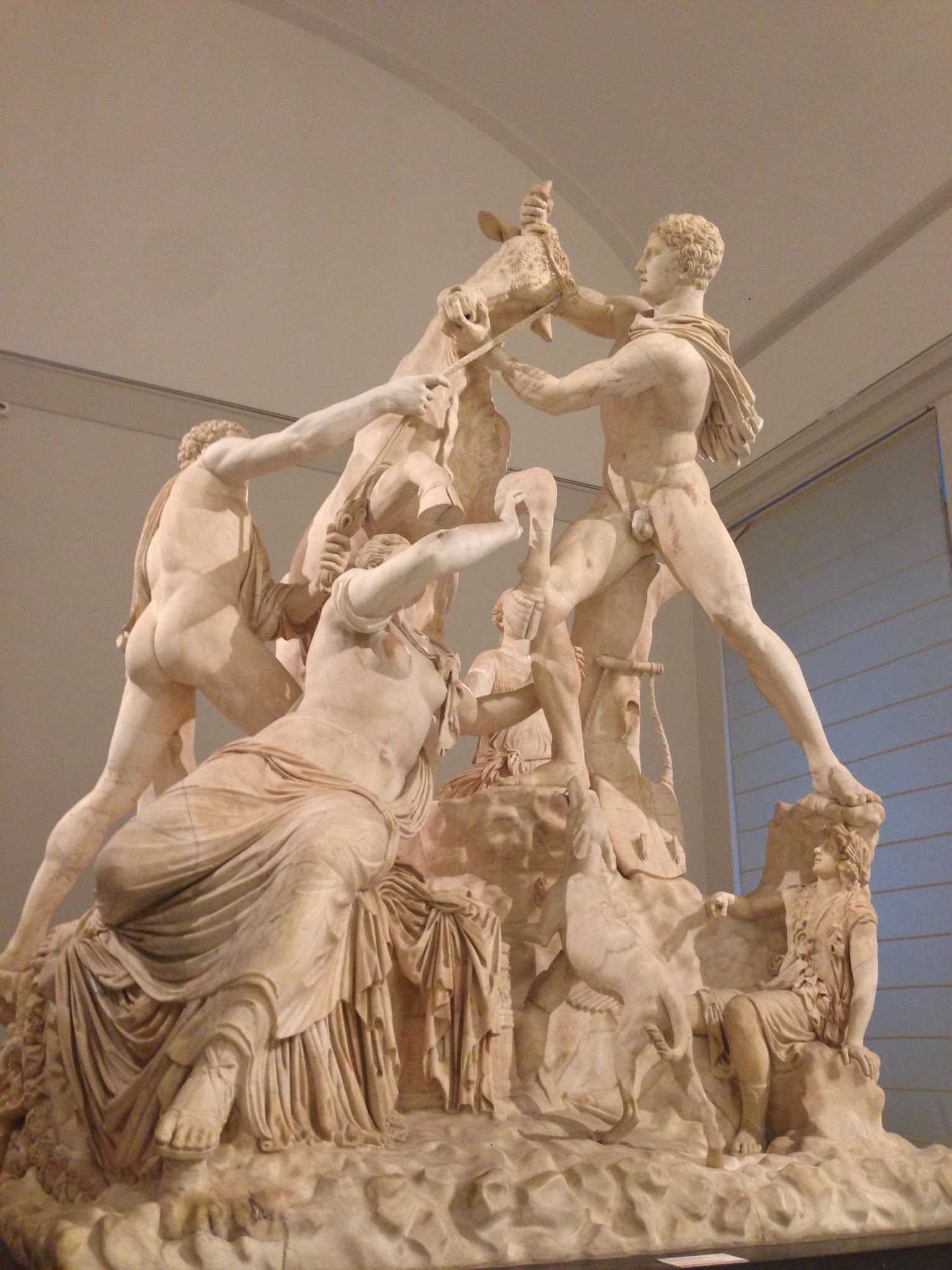
The Farnese Bull (c. 200–180 BCE), named for the patrician Roman family who owned the statue in the Italian Renaissance , is believed to have been created for the collection of Asinius Pollio, a Roman patrician. Pliny the Elder attributes the statue to the artists and brothers Apolllonius and Tauriscus of Trallles, Rhodes.The colossal marble statue, carved from a single block of marble, depicts the myth of Dirce, the wife of the King of Thebes, who was tied to a bull by the sons of Antiope to punish her for mistreating their mother. The composition is large and dramatic, and demands the viewer to encircle it in order to view and appreciate the narrative and pathos from all angles. The various angles reveal different expressions, from the terror of Dirce, to the determination of Antiope’s sons, to the savagery of the bull.
square spaces for either painted or sculpted decoration
Greek, "young man;" a sculpture of a male youth
Greek, "young woman;" a sculpture of a female youth
a style of representation that seeks to recreate the visible world or nature
a style of representation that perfects or makes "ideal" the subject's features, proportions, etc., in accordance with prevailing beauty standards
a rule for a standard of beauty developed for artists to follow
Styles of Classical architecture, each distinguished by its proportions and characteristic profiles and details, and most readily recognizable by the type of column and capital employed; three of the five Classical orders of architecture were developed in ancient Greek periods: Doric Order, Ionic Order, Corinthian Order [Art History Glossary]
the element at the top of a column or pilaster
in Greek temple architecture, the part of the entablature above the architrave and often bearing painted or sculpted decoration
having decorative grooves
ornaments, shaped like scrolls or cinnamon rolls, that are notable features of Ionic capitals
the closed, inner part of a temple that housed an image of the deity
the triangular space forming the gable of a pitched roof in classical architecture [Art History Glossary]
entranceway of a Greek temple
a row of evenly-placed columns
the inner sanctuary of a Greek temple
a stance in which the figure bears weight on one leg, shifting the hips, chest, and shoulders into a more naturalistic, realistic pose
a sculpture technique in which a clay mold is coated in wax, covered in plaster, and then heated, causing the wax to run out. Molten metal is then poured into the resulting channels, allowed to cool, and the mold broken so that the sculpture can be removed and polished.
"high city," from the Greek akro-, (edge or extremity) + polis (city). Although many Greek cities had an acropolis, the most famous was in Athens, and "The Acropolis" refers to it.
weight-bearing columns sculpted in the form of women
In sculpture, the look of sheer, almost transparent cloth—called "drapery" in art—that appears to cling to the body, exposing the form beneath; introduced in the Greek High Classical period before sculpture depicting the fully-nude female figure was acceptable; the sculptor Phidias is credited with introducing this style [Art History Glossary]
slight adjustments in Greek architecture to account for the perception of human vision, such as slightly swelling the middle of a column so that it would not appear to taper in the middle
a painting medium in which the binder for the pigments is hot wax
traditionally, a painting medium in which the binder for the pigments is egg yolk
from the Latin chiaro (light) + scuro (dark), the artistic technique of combining light and shadow to create the illusion of three-dimensional form
in true, or buon, fresco, pigments are applied to wet plaster and the resulting painting becomes part of the wall itself, with vivid and well-preserved colors. In fresco secco, wet pigments are applied to already dry plaster.
a technique in which an image is formed using small pieces (tesserae) of hard material, such as stone, glass, and/or metal
sculpture that, unlike free-standing or in-the-round sculpture, doesn't detach entirely from its background. High-relief sculpture projects far from the background, whereas low-relief, or bas-relief sculpture is relatively shallow.
a winged personification of victory
